There are several adventure-packed National Parks near Las Vegas! In this post, we share our itinerary for a week-long road trip from Las Vegas to National Parks that will leave you fulfilled and ready to plan your road trip out west! This Las Vegas National Park road trip includes 12 National Park Units in Nevada, Southern Utah, Arizona and California covered in 6 days – all from a starting point in Las Vegas.
Day 1: Experience Great Basin National Park
Road trip from Las Vegas to Great Basin National Park
We arrived in McCarran airport right around 8am Pacific. Flying Southwest Airlines from Columbus got us in a little earlier than planned. Our early arrival was extremely helpful to us as we had to pick up our luggage, pick up our rental car, grab some groceries and necessities for our road trip, and make it to Great Basin National Park for a 3pm cave tour!
Great Basin National Park is one of the least visited parks managed by the National Park Service. In 2018, only around 150,000 visitors entered the park. The quiet and serene vibe that you will experience is a definite change in pace from the party life of Las Vegas only 4.5 short hours (~300 miles along US-93) to the south.
Pro Tip: Drive on a full tank of gas. This is some advice that we received going into the trip, and it held true! Many of the roadways that we traveled on this trip were pretty sparsely populated, so it is a good idea to stop and fill up your tank when you approach a gas station. After you get outside of Las Vegas, gas stations along US-93 are scarce.
Things to do at Great Basin National Park
Great Basin National Park is in a remote area of the state near the sparsely populated community of Baker, Nevada. We were hoping to venture to Wheeler Peak which is one of the featured scenic drives in the park that takes you up in elevation to 13,000 feet. When we visited in mid-May, however, the road was closed due to snow.
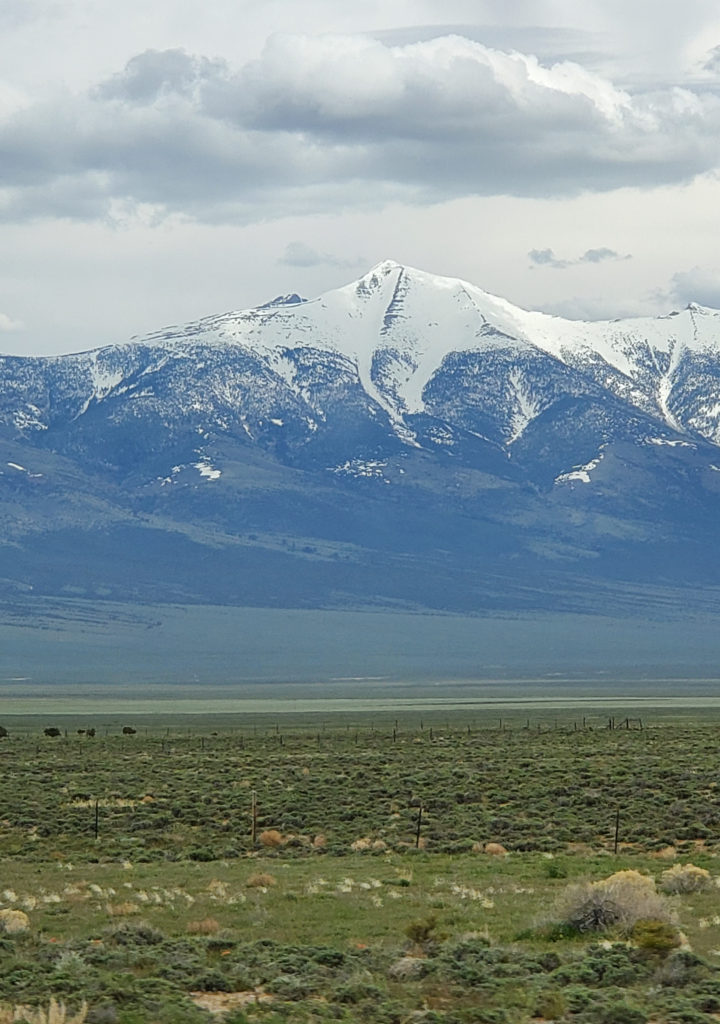


In advance of our trip, we booked a tour through Lehman Caves (link to recreation.gov to book a tour). There are three separate tours that you are able to book in advance (or on site, but be careful – the availability is limited and first come, first served):
- Gothic Palace Tour (a 30-minute accessible tour)
- Lodge Room Tour (a 60 minute tour)
- Grand Palace Tour (a 90 minute tour that extends beyond the Lodge Room Tour)
Exploring Lehman Caves is one of the most popular activities to do in the park. We booked the Lodge Room tour because it was the latest tour that there was on the day that we arrived. Our flight arrived at McCarran airport at 8 am, and after picking up our rental car and stopping at the grocery story to grab some necessities for our trip, we made it to our 3pm tour time with 15 minutes to spare! Read more about our Lodge Room tour experience here.
If we were to spend more time in Great Basin, I would love to do some star-gazing. One of the perks of being in a remote area is that you can see every star in the night sky! The park has some programming related to its designation as an International Dark Sky Park.
Great Basin is definitely one of the National Parks near Las Vegas that is worth a visit. It’s one of the least visited National Parks, so you don’t really hear about that often!
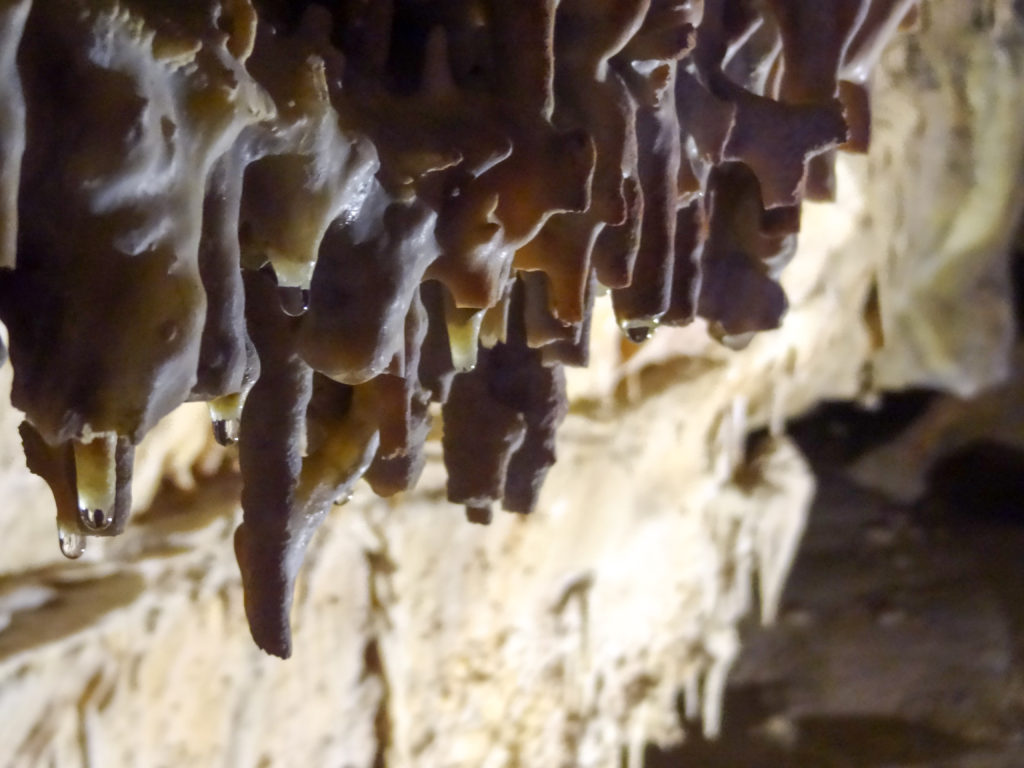


Traveling from Great Basin National Park to Brian Head in Utah
Our first day concluded with a 2.5 hour drive from Great Basin to the town of Brian Head in Utah.
Before we left the Baker, Nevada area, we needed to get some gas. We found an abandoned-looking gas station with no shop / concession area, just unattended pumps in the middle of pavement. This seemed strange, but we drove in to explore anyway because we were told that the nearest gas station was dozens of miles in the opposite direction of where we needed to go. We found that this gas station was a credit card only pump, and were relieved that we were able to fill up!
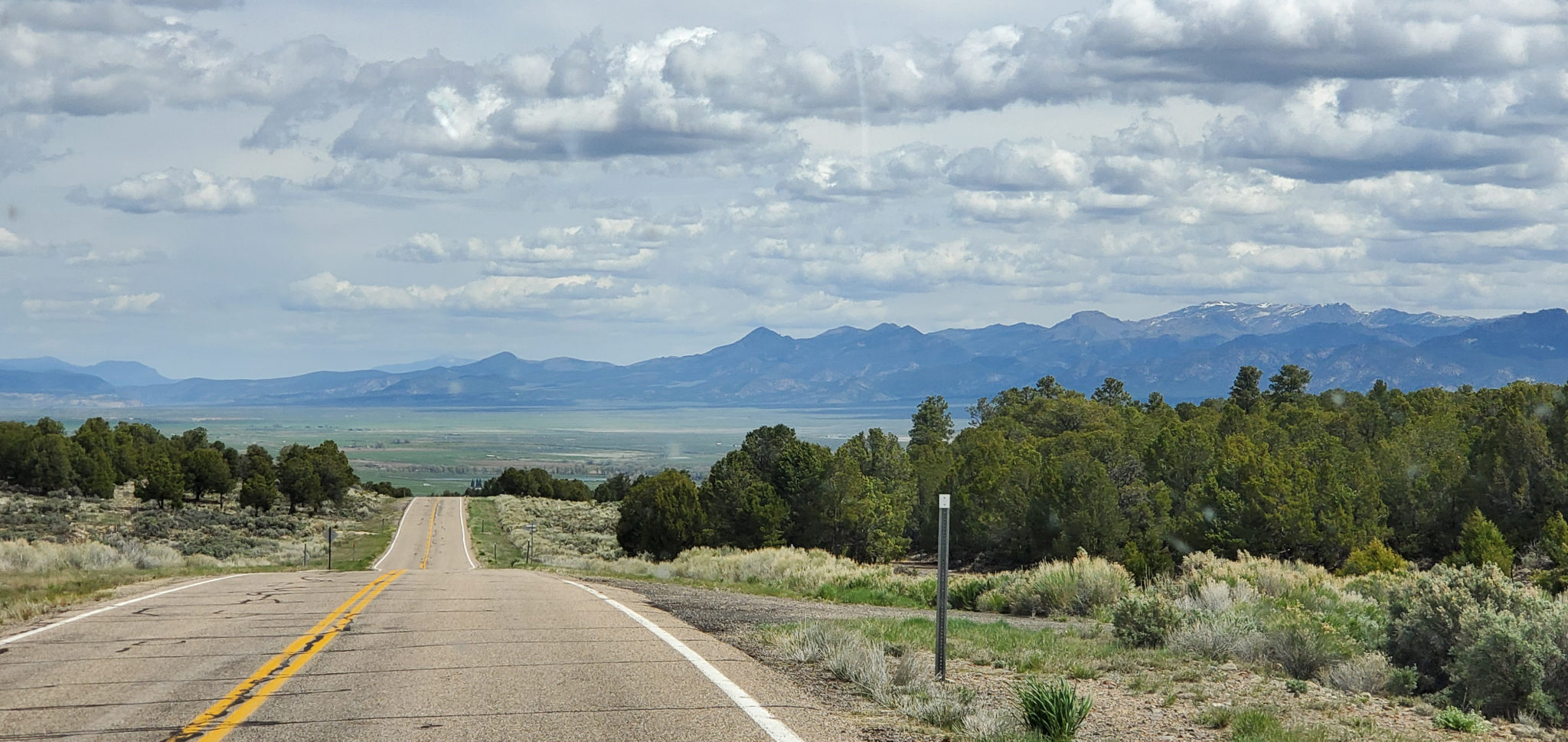


We chose Brian Head because of its proximity to the first stop scheduled for Day 2 – Cedar Breaks National Monument. We stayed in a lodge-style resort hotel: the Best Western Premier Brian Head Resort.
On our drive, we encountered more sparsely populated roadways and meandered through a couple of small towns and communities in the valleys along the way. Along one particularly empty stretch of road, we passed a lone farmer that was sitting on his porch that waved at us with a friendly smile… I wondered if we were the only passers by he had seen the entire day.
Things to Know When Visiting Brian Head, Utah
There are a couple of things to know about Brian Head that caught us off guard a little bit.
- Brian Head, Utah is a ski resort town that sits over 10,000 feet in elevation. Driving at that elevation can be scary – and you will drive through some rather steep switchbacks that can rattle the nerves. Keep this in mind if you don’t like those kinds of roadways.
- Because of the elevation, the temperature (and wind) is conducive to lingering snow. While we were lucky that the main roadways were clear during our mid-May visit, there were several inches to feet of snow around on the ground.
Pro Tip: When you are visiting areas that are relatively high in elevation, make sure to stay hydrated! Altitude sickness can set in, and you can become dehydrated easily without even realizing it.
As we got closer to Brain Head, our route took us by the Parowan Gap petroglyph area. It’s neat to see because there’s really nothing dynamic about the setting, and then you see ancient markings on the rocks that jut out of the ground. Pretty cool! We were tight on time because we ultimately lost an hour as we passed from Pacific to Mountain time (leaving Nevada and entering Utah) and the sun had pretty much set.
Day 2: See Cedar Breaks National Monument, Tour Bryce Canyon National Park (all the way to Rainbow Point) and end up in Zion National Park
Waking up in Brian Head, Utah rested from the previous days travel, we were excited for the promise of adventure and adding some iconic parks to our “been there” list. Our first stop of the day was to Cedar Breaks National Monument, a lesser known and lesser visited park only a few miles down the road from our hotel.
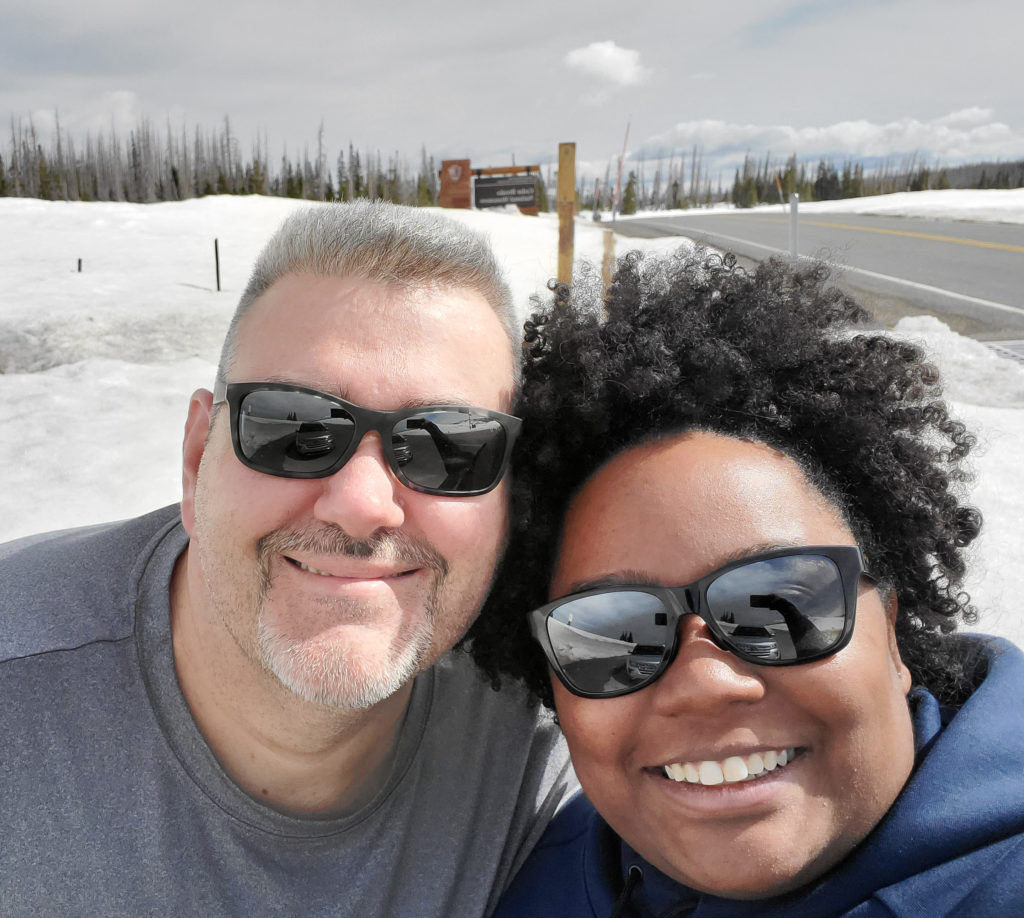


Though our visit was in mid-May, Cedar Breaks missed the “April showers brings May flowers” memo (hello elevation from your naive mid-western friend)! We were greeted with bitingly cold winds and stale snow – the kind that has been thinking about melting, but stubbornly hangs on and hardens (though watery evidence of a revolt hits the streets).
At dinner the night before at our hotel, my expectations were set by our awesome waitress when she indicated that we were not going to be able to drive the scenic road (Utah-148) through Cedar Breaks as it was closed and covered with snow. She did indicate that there was a pull off, the first on the scenic route that was accessible by the road we were traveling (Utah-143). That being said, my mind was made up. I was going to get to take in the views of the Cedar Breaks hoodoos after all!
Visiting Cedar Breaks National Monument
While visiting Cedar Breaks National Monument from the pull off described above is completely possible, during our trip, this proved difficult due to snowy and windy conditions. Even though we tried to see the hoodoos from this view – the only one that we had the possibility of observing during our visit, I ended up with a frigid reality check (I dramatize my embarrassing experience with getting stuck in the snow here), and ultimately decided that the grand vistas would be something we’d have to observe on our next trip :-(.
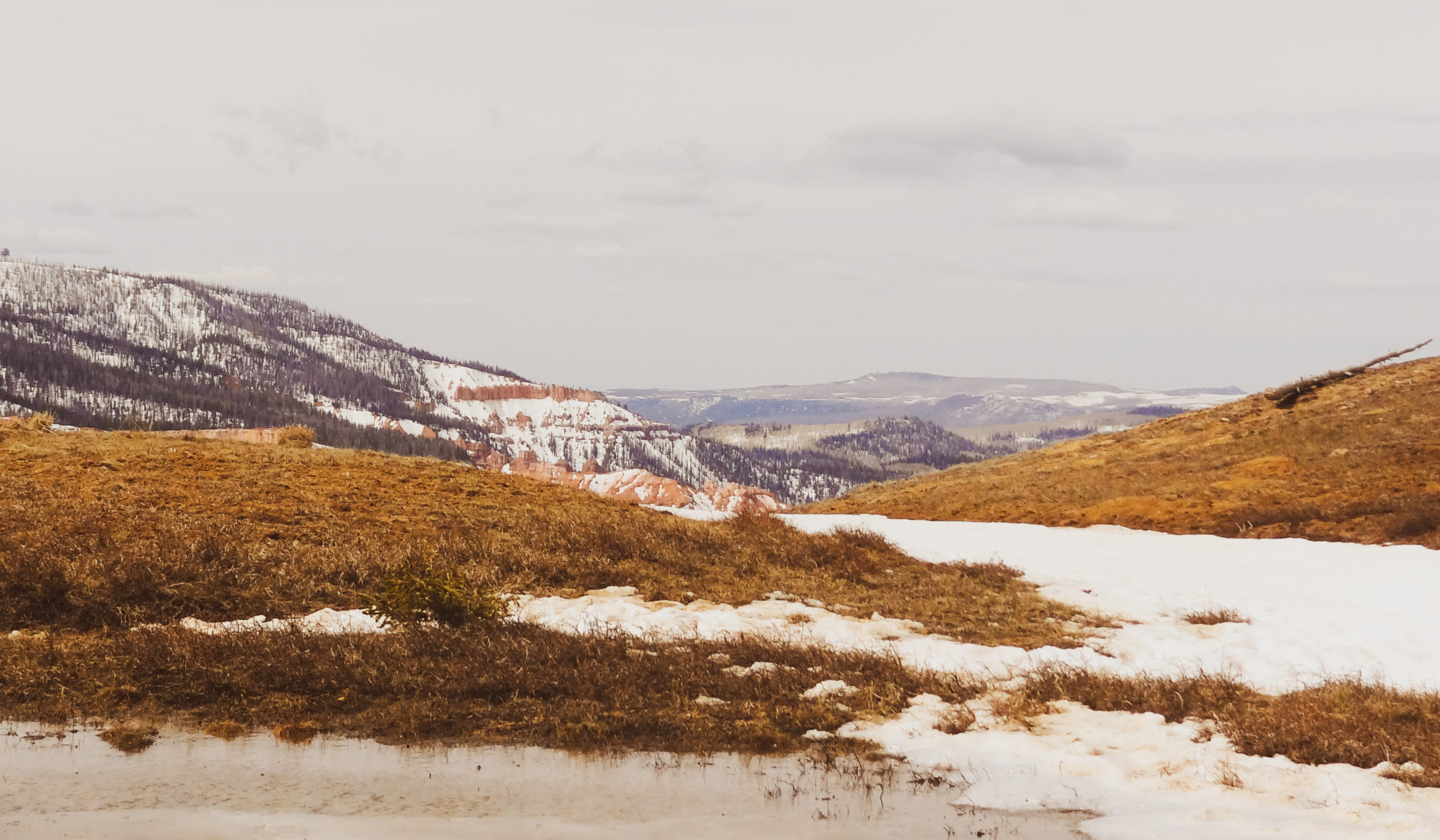


Pro tip: Even though the NPS website says that Cedar Breaks Visitor Center along Utah-148 opens typically during mid-May, they underscore that this decision is conditioned upon the weather. We took the risk of trying to visit the park during mid-May, and the weather did not work out in our favor. If you really want to go into the park and do not have experience with winter activity (i.e. snowshoeing), you may want to wait until mid-June at the earliest to plan your visit.
Driving from Cedar Breaks to Bryce Canyon National Park via Utah-143
The drive from Cedar Breaks to Bryce Canyon National Park took about an hour and a half. The drive was beautiful as we stepped down in elevation through Dixie National Forest. My favorite part of the drive was the stretch of road that ran alongside the gorgeous Panguitch Lake.
Not too long after coming off the mountain after Panguitch Lake, you will enter the town of Panguitch which is a good stopping point to fill up on gas before continuing onto Bryce Canyon.



Red Canyon – An Unexpected Surprise as we approached Bryce Canyon National Park
As we turned off of US-89 onto Hwy-12, we were greeted by an unexpected treat! The research that I had done on Bryce Canyon basically began and ended within the boundaries of the park. We were pleasantly surprised to pass through another beautiful scene that heightened our excitement to see Bryce Canyon as we passed through Red Canyon.
We hit Red Canyon about 15-20 minutes outside of Bryce Canyon. You get to see some gorgeous brightly colored hoodoos, and are able to pull off at a number of parking areas to get out and enjoy the views.



Visiting Bryce Canyon National Park
When we entered the park, we were greeted by the National Park sign (where we always try to stop and take a photo). There is a parking area right by the sign which is nice (not all parks have actual parking spots for this). I’m thinking, though, that the spots were put there out of necessity because there were quite a few folks that were there taking pictures. This was a reminder that Bryce Canyon is a more frequently visited park than many that we’ve been to up to this point.
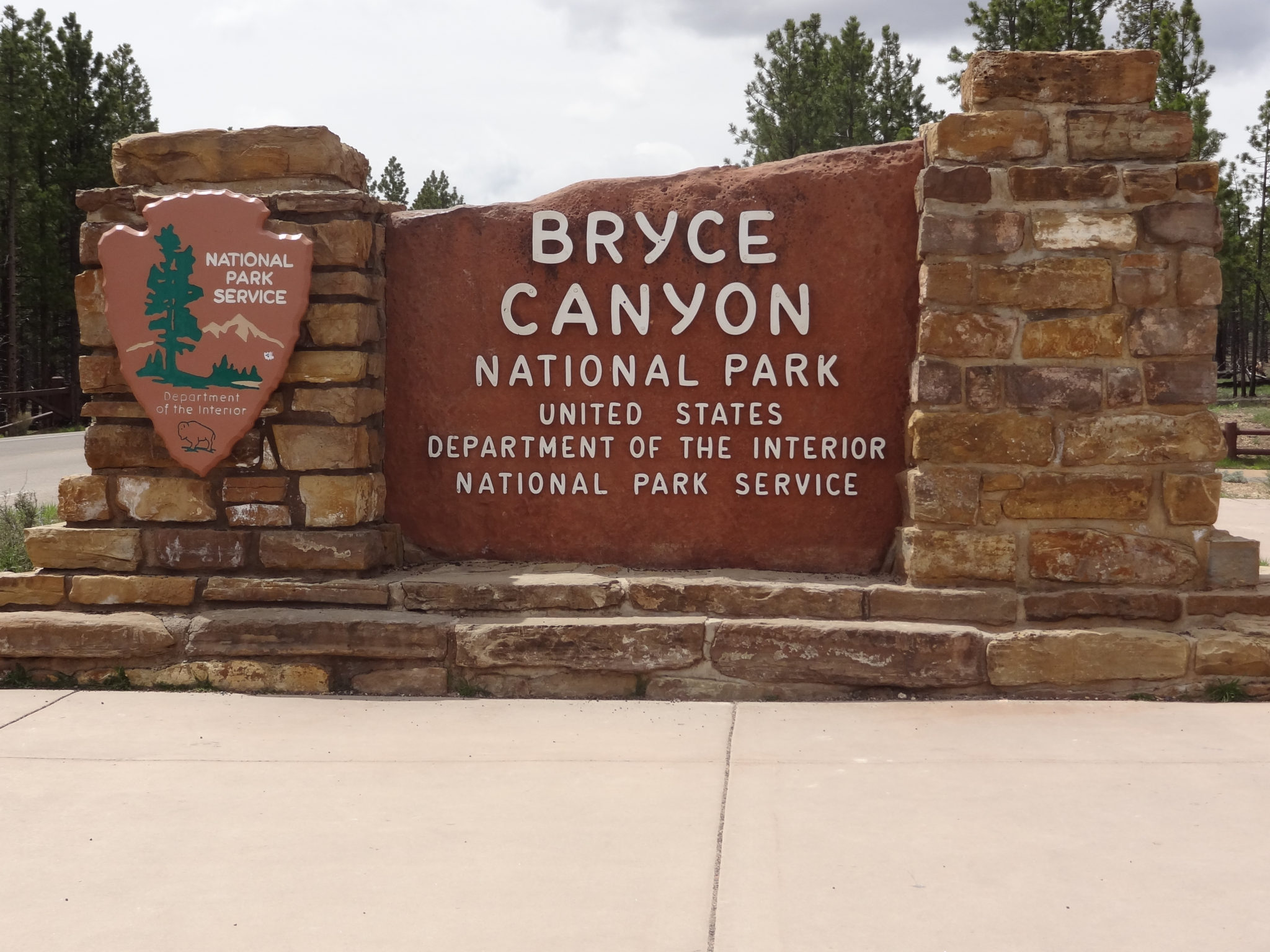


We entered and went to the Bryce Canyon National Park Visitor Center to get our passport stamp and to check out the beautiful displays that told the story of the geology of the park. We had a little bit of time to explore before heading to pack our lunches for our tour that we had scheduled a week before our trip.
A week prior to our trip, we were able to book the free Rainbow Point Shuttle Tour offered by the park which takes you on a longer tour than the regular shuttle circuit that circulates every few minutes during the day. Our tour was one of only two guided tours that leave each day and lasts for about 4 hours. On it, you make a drive out to Rainbow Point (where the road in the park dead ends and you look out into the Grand Staircase) and back, stopping at a few of the parks famous vistas.



We highly recommend the tour if you want to learn about some of the behind the scenes stories of the park. You get to enjoy the views without being behind the wheel of your own car. This tour also takes you beyond the typical loop that runs throughout the day in Bryce Canyon, so you get a rich experience!
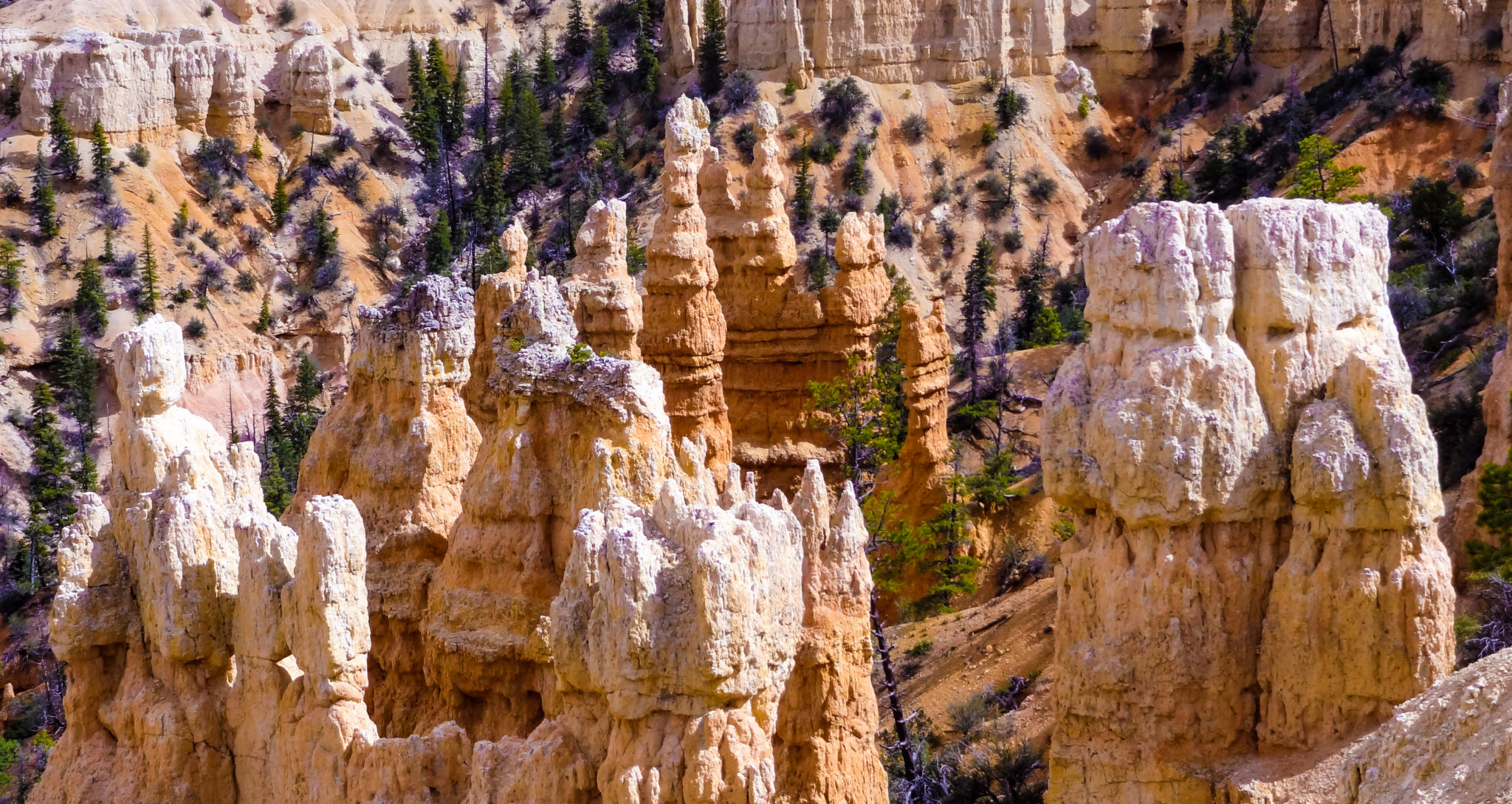


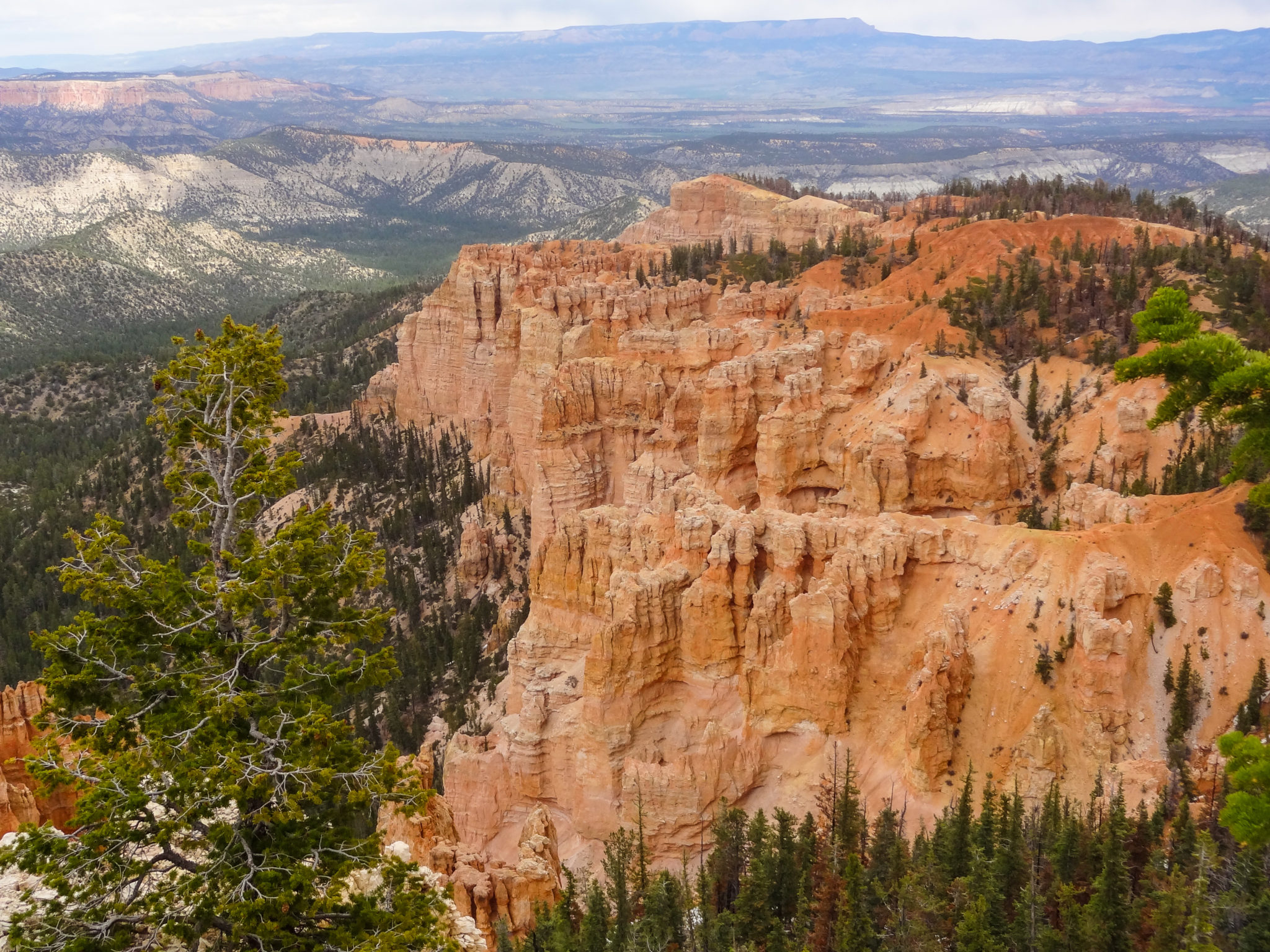


Entering Zion National Park Via UT-9 (the Zion-Mount Carmel Highway)
When we left Bryce Canyon, the clouds had grown thicker and rain was looming. We knew that we needed to make some moves in order to reach our Springdale, Utah hotel reservation before dark. We said our farewells to the beautiful hoodoos via the same roads that took us to them, and started our trek to Zion.
The Zion-Mount Carmel Highway is high on my personal list of top scenic routes that I have ever driven! As we approached Zion from Bryce Canyon, the weather had deteriorated and we were driving through a complete and utter downpour. This was stressful to drive through to say the least! By the time that we made it to the park entrance though, the rain had calmed to a light sprinkle. The recent torrent of rain, however, made for the most gorgeous pop-up waterfalls through Zion. It was simply breathtaking!
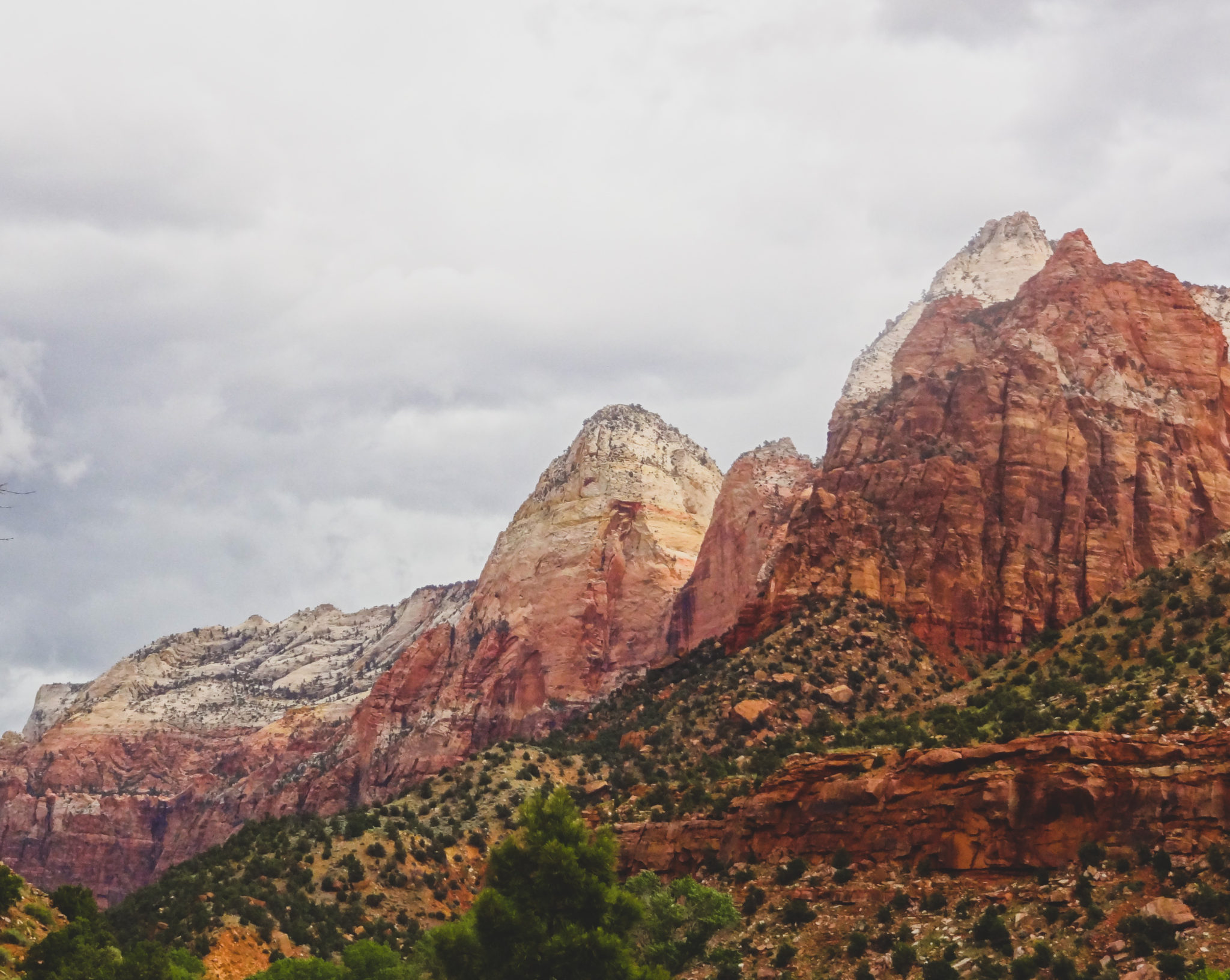


ProTip: If you are able to see Zion during a rain event, you are in for a treat! Stick around even if it’s uncomfortable as the life-giving pop up waterfalls will be a salve for any ailment that afflicts. I would alter my entire road trip if I got a chance to experience that again!
Staying in Springdale, a gateway town at the entrance of Zion National Park
We decided to go to the Visitor Center to get our Passports stamped so that we wouldn’t have to carry those into the park the next day, and went to check into our hotel in the visitor-centric town of Springdale, Utah.
We stayed at the Best Western Plus Zion Canyon Inn & Suites which was comfortable and clean. One thing that I liked about it was that it was right across the street from one of the Springdale shuttles that take visitors to the entrance of Zion National Park.
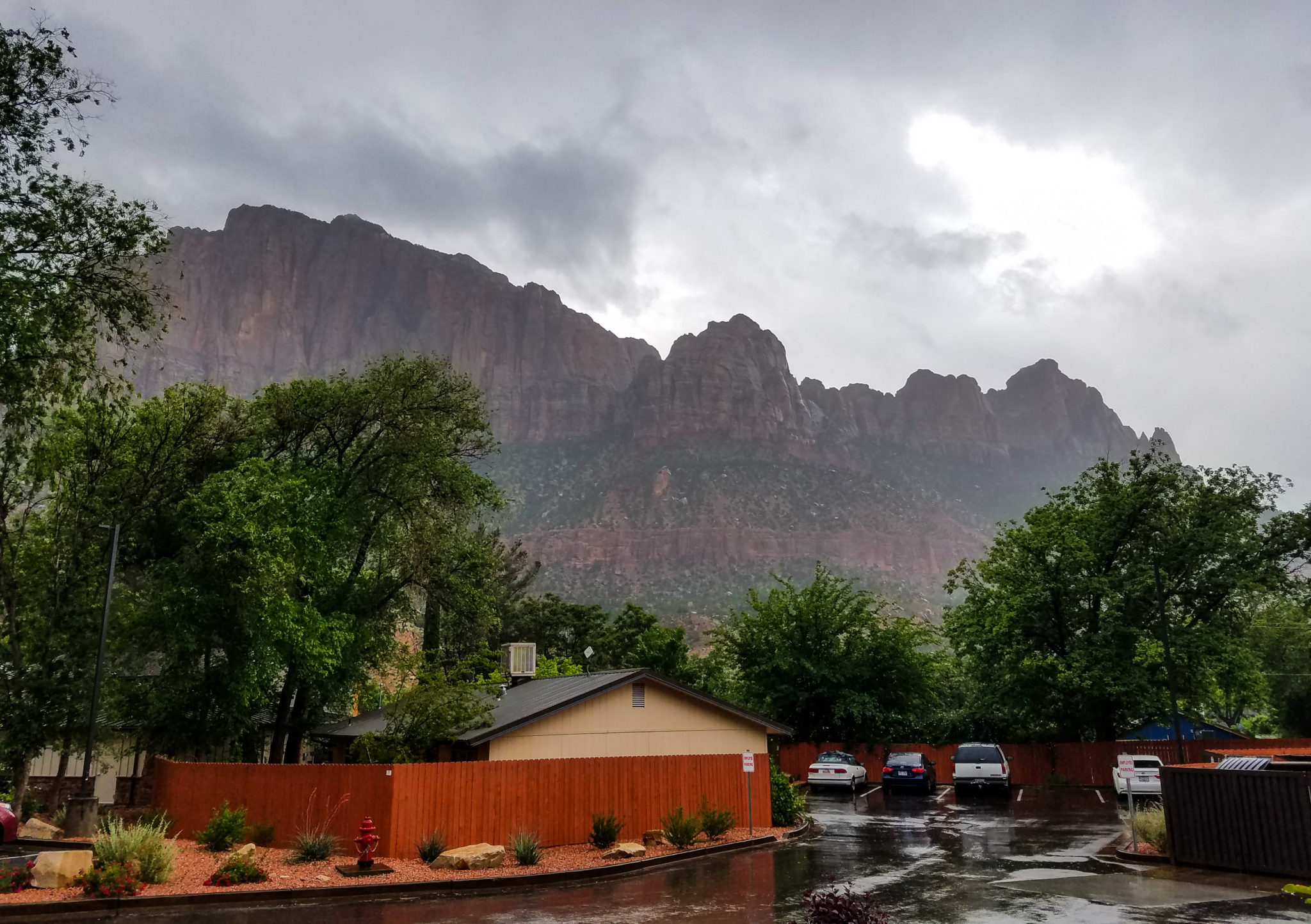


It was difficult to find a place to eat when we arrived around 9. A lot of places were either closing/closed, or had long waits. Parking was scarce at the restaurants that appeared to be open. We ended up checking out the Bit & Spur Southwest Grill and were very happy with our experience.
Day 3: Zion National Park and Pipe Spring National Monument to Page, Arizona via the Grand Staircase Escalante
I was already in love with Zion, so waking up the next day knowing that I would have the better part of the day to explore lit me on fire! I was tired from driving and little sleep, but my thirst for seeing as much of this park as possible pushed me forward. We ate breakfast at the hotel and dressed for a day of hiking.
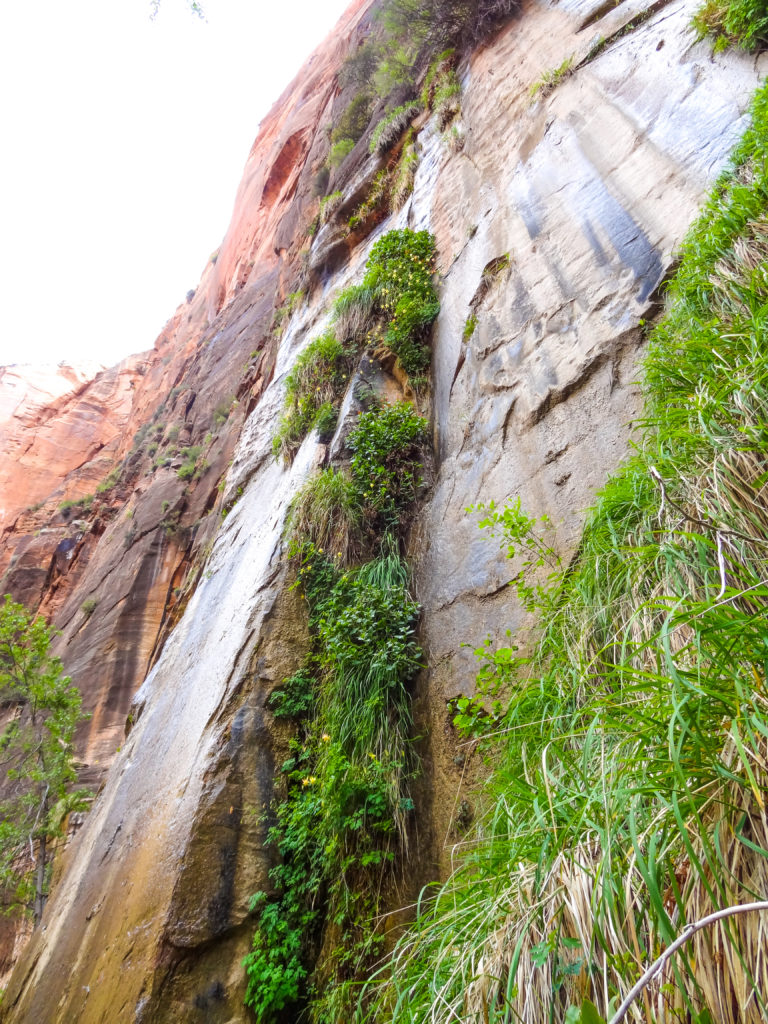


Catching the Springdale Shuttle to enter Zion National Park
Our research for our Zion experience made us confident in the Springdale shuttle system that operates for free to take people into the park. We waited only a few minutes – chatting it up with visitors from New York that had recently arrived as well – and were quickly on our way into Zion bright and early! The shuttle was clean, but the seats were super narrow. It was free, so I don’t want to complain too much… but you can tell that the volume play is a consideration in the design.
We exited the bus after only a couple of stops, and walked across a bridge to board another shuttle, this time within the Park boundaries.
Catching the Zion Shuttle to the Riverside Walk
The shuttle within Zion National Park takes visitors through the 9 stops, deep into Zion. We visited the parks maps well in advance of our trip, so we had our plan of action (good thing – it would have taken time to figure it all out on the spot). After waiting in line (not too long as we visited in the mid-May shoulder season), we rode the entire length of the route to stop 9 – the Temple of Sinawava. Here, we exited for our chance to complete the Riverside Walk.
Hiking in Zion National Park
The Riverside Walk is one of the more popular hikes at Zion NP that takes visitors to the entrance of the Narrows, a water walk deep into the canyon. Because we went early in the morning, we didn’t have to wait long for the shuttle, and there were not a lot of other hikers that competed with us for space on the trail (which I have read can sometimes be a problem in this popular and more crowded park).
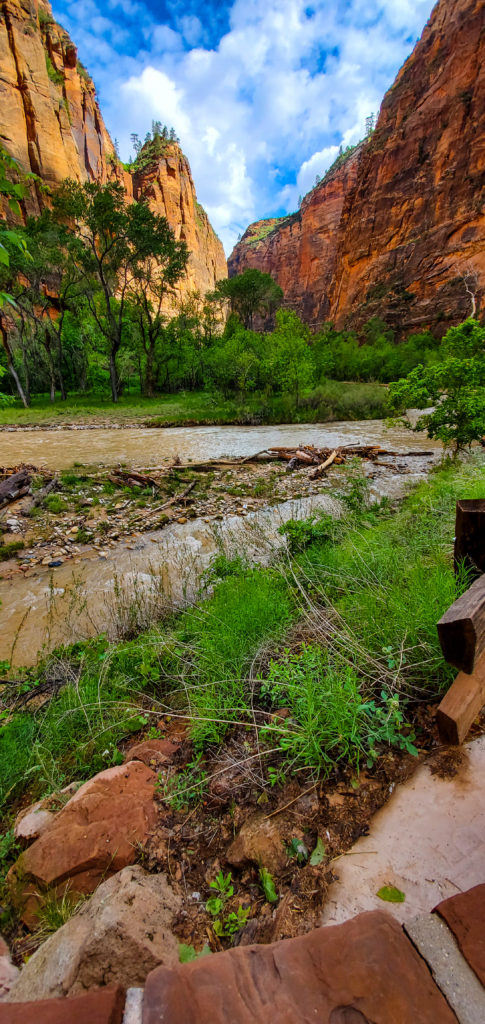


This hike was a gorgeous 2.2 mile (out and back) walk on more-or-less easy, paved walkways. There are some inclines, and we opted to walk on a sandy trail alongside the water for a bit. You will get to see some neat rock formations, rock squirrels and other animals, and (new for me) hanging gardens! I would do this walk again in a heartbeat!
Then we backtracked, caught the shuttle again, and walked the Grotto Trail (~1 mile from point to point) from stop 6 to the Zion Lodge (stop 5). After the Riverside Walk, the Grotto Trail was comparatively uneventful because the scenery was mostly flat and grassy. The park literature says that you have a chance to see some of the park wildlife, but we weren’t so lucky.



Other things to do in Zion
We made a quick visit to the iconic Zion Lodge, and visited the Human History Museum (got another stamp there for our passports). We were also able to view the park video before we hopped the Springdale shuttle back to our car. As a quick aside, there was a pretty lengthy line to catch the Springdale shuttle from the park to the hotel (it took maybe about 20 minutes before we were able to catch a shuttle back). Check out our post on things to do in Zion National Park in One Day.
Despite its manifold attractions, our stay in Zion was relatively short. Since I connected instantly to the park, I would have loved to have spent the rest of our vacation time in Zion!
Pro tip (when traveling fast): Remember that you can always go back! Spending too little time in what you discover is one of your favorite places is one of the unfortunate side-effects of trying to see a lot of places in a short amount of time. I had to keep reminding myself that I could go back to Zion one day. I hope sooner rather than later. I loved that park!
Leaving Zion to Head to Pipe Spring
All good things must come to an end. And our visit to Zion came to a much earlier end than I would have liked. Alas, because we were on a quest to see the National Park units in the area, we wanted to leave by 1 pm in order to make it down the road to Pipe Spring National Monument.
Along the way, from Zion to Pipe Spring and then to Page, Arizona, you will be driving through the lovely Grand Staircase Escalante National Monument. You can see this dramatic view from Bryce Canyon’s Rainbow Point. You also get to experience it up close and personal as you make progress to Page.
Visiting Pipe Spring National Monument
Pipe Spring National Monument tells the story of the humans that resided in this area in Southern Utah. It is a Monument that is jointly offered in collaboration with the Kaibab Paiute Indian tribe. In fact, the location of the Visitor Center is right next to tribal offices and neighborhoods. The site protects artifacts of the Mormons, the Kaibab Paiute, and the Pipe Spring that flows til this day, delivering life giving water to the inhabitants.
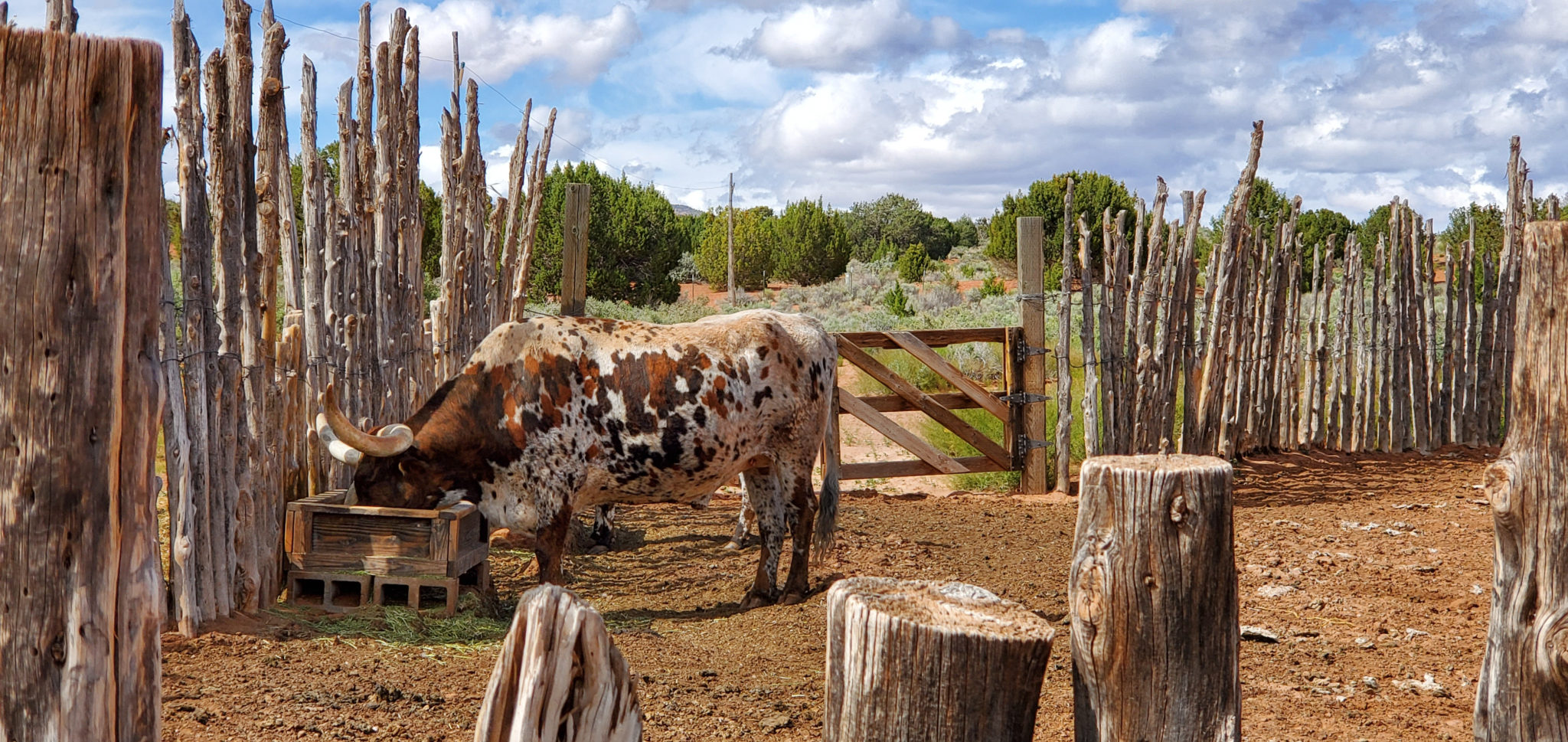


The day that we visited, Winsor Castle, an old Mormon fort that is one of the primary attractions in the park, was available as an open house. A class of children accompanied by parent volunteers joined us in visiting the small fortress that Mormon settlers held. Right outside were wagons, farm setups, and replica Indian homes for visitors to explore.
The site is complete with a beautiful bookstore that contains artwork from local artists.
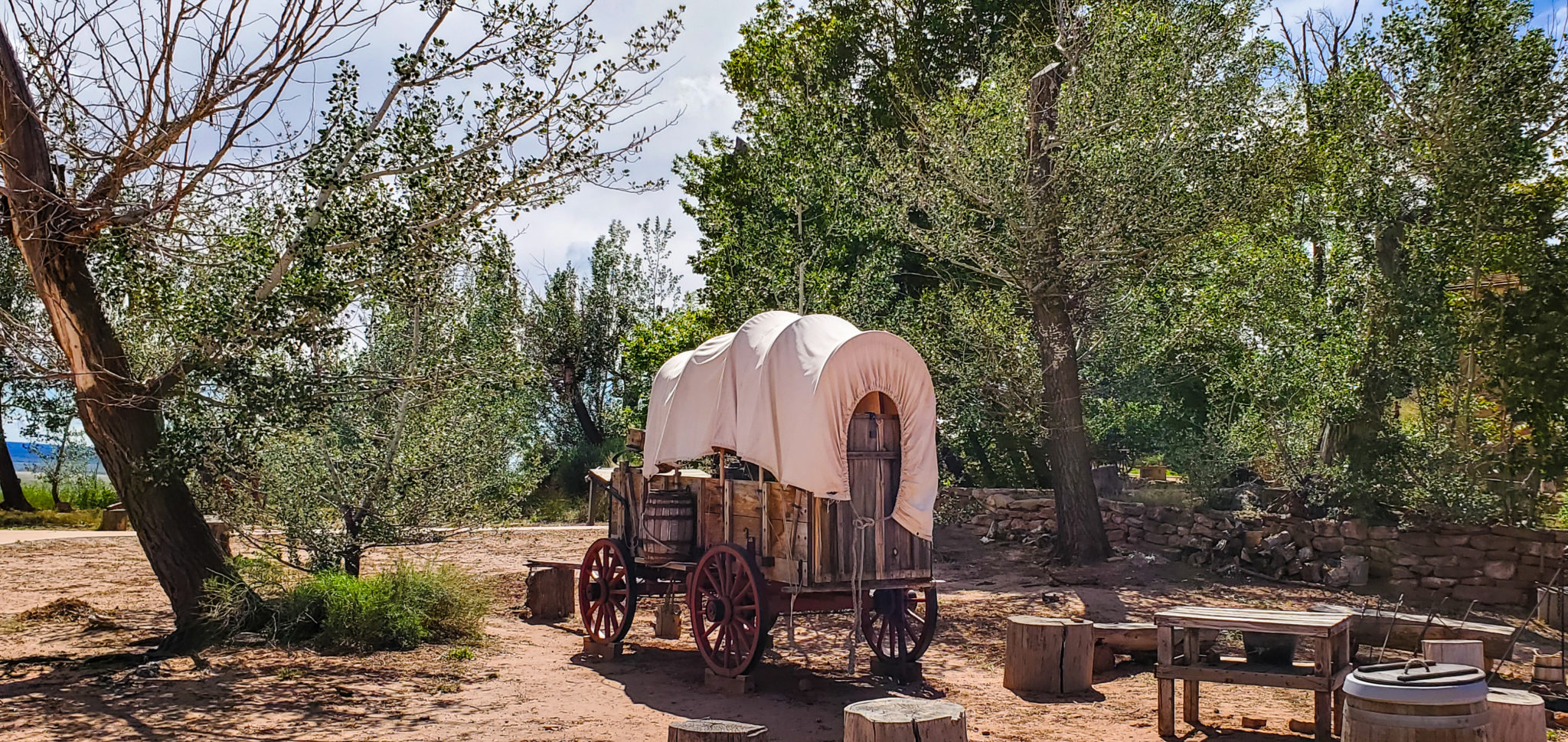


Pro Tip: The time zone changes frequently between southern Utah which is on Mountain time and Arizona which is on Pacific time. Leaving Zion a bit later is possible because you “gain” an hour when you visit Pipe Spring.
Day 4: Glen Canyon National Recreation Area, Rainbow Bridge National Monument and Horseshoe Bend
Waking Up in Page, AZ
Page, Arizona is one of the coolest places that I have visited. It’s just a small town on the periphery of the Grand Staircase – Escalante, but its charm is etched into its visitors.
We stayed in Page for 2 nights on our trip which gave us the opportunity to rest up a bit instead of continually hopping from one hotel to another (this is a Pro Tip if you like fast travel, but need to rest up a bit). Arriving in the late afternoon at our hotel (Country Inn and Suites by Radison), we enjoyed a great dinner at Gone West Family Restaurant before calling it a night.
We woke early the next morning knowing that we were in for a treat! We had booked a tour through the Glen Canyon National Recreation Area to the astoundingly beautiful Rainbow Bridge National Monument. We did not want to run the risk of being even the slightest bit late. That being said, we packed up our belongings for a 7-hour round trip, and headed to the Wahweap Marina to board our vessel.
Rainbow Bridge Boat Tour
While not cheap (we paid ~$170 per person), the Rainbow Bridge boat tour was absolutely worth the expense. We were on a double-decker cruise boat with pleasant staff and comfortable seats. On this cruise, you travel ~50 miles of Lake Powell, and get to admire the mesas, boulders and hoodoos that dot the landscape along the way.
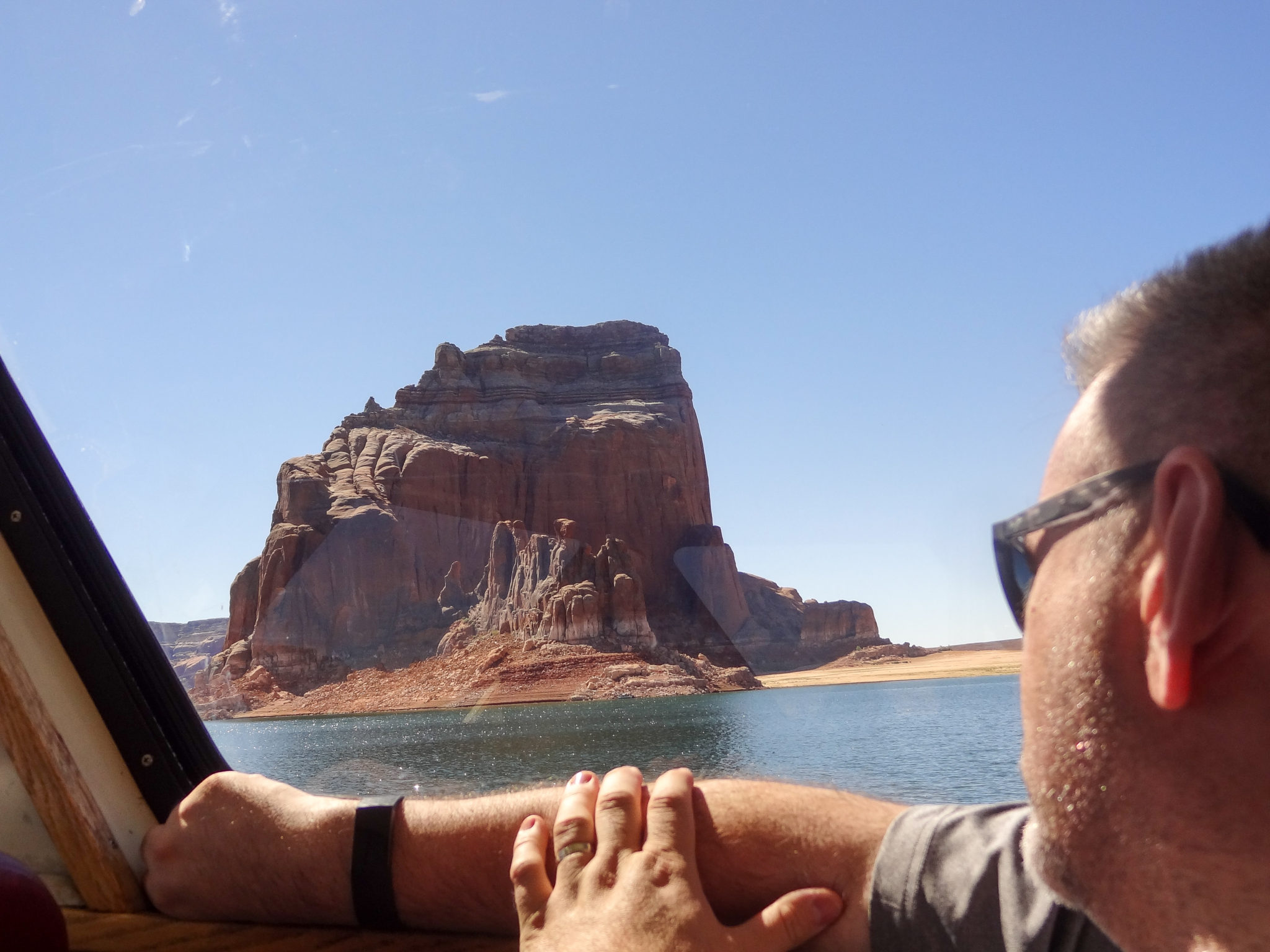


Water excursions are some of my favorites, and getting to take the relaxing ~3 hour ride out to Rainbow Bridge and ~3 hour ride back was a perfect experience! Also, there is coffee, lemonade and granola bars that are served on the boat which were all really tasty (after days of chowing down on PB&J sandwiches and drinking lots of water). You are also able to bring a (very much needed) packed lunch.
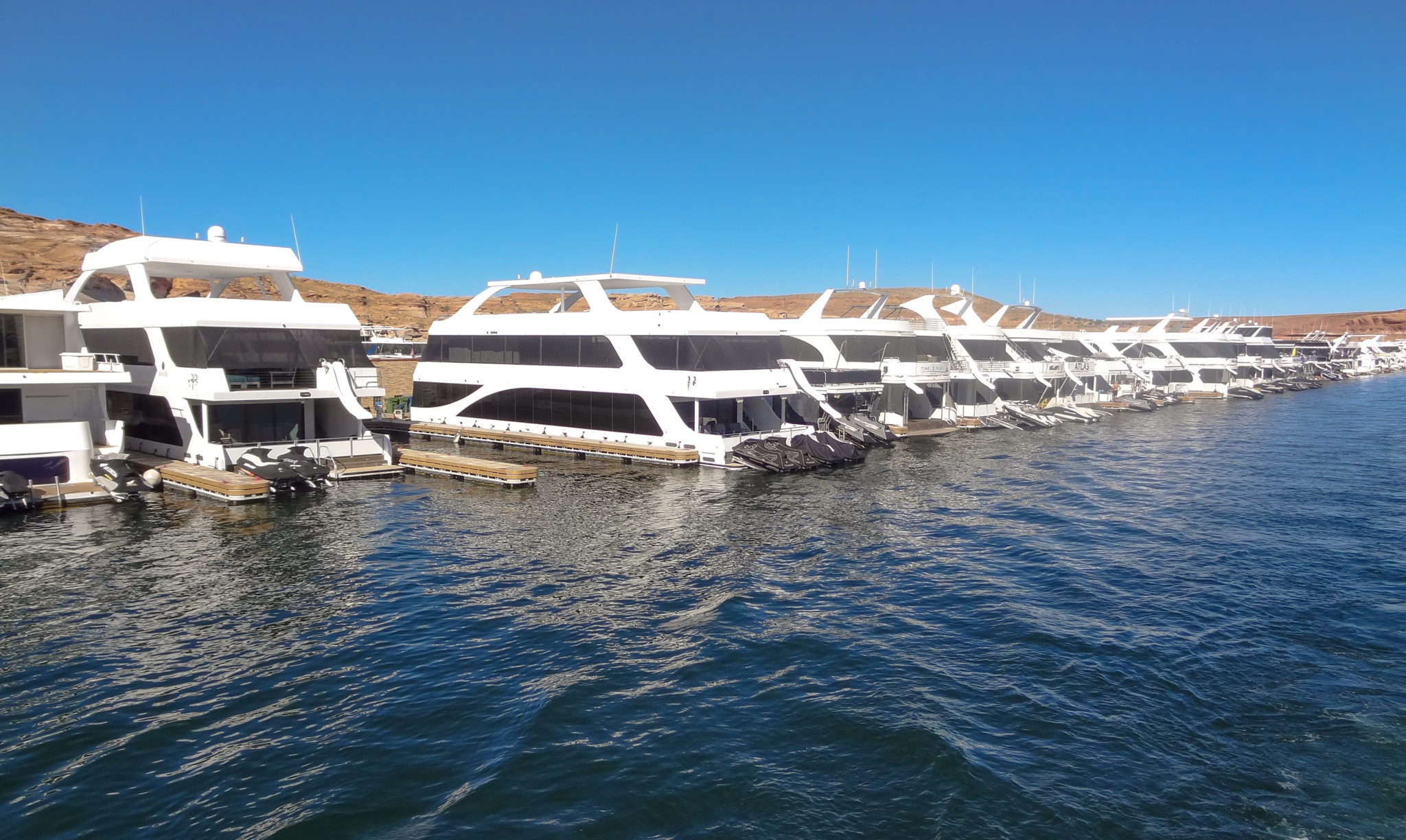


With hours of this gorgeous scenery, you get a chance to be at peace with your thoughts and ideas. The only downside is that the area where you check in is quite an uphill trek from where you board the boat. There are a couple of golf carts ushering folks that needed a lift up and down the hill, but otherwise, you have to rough it.
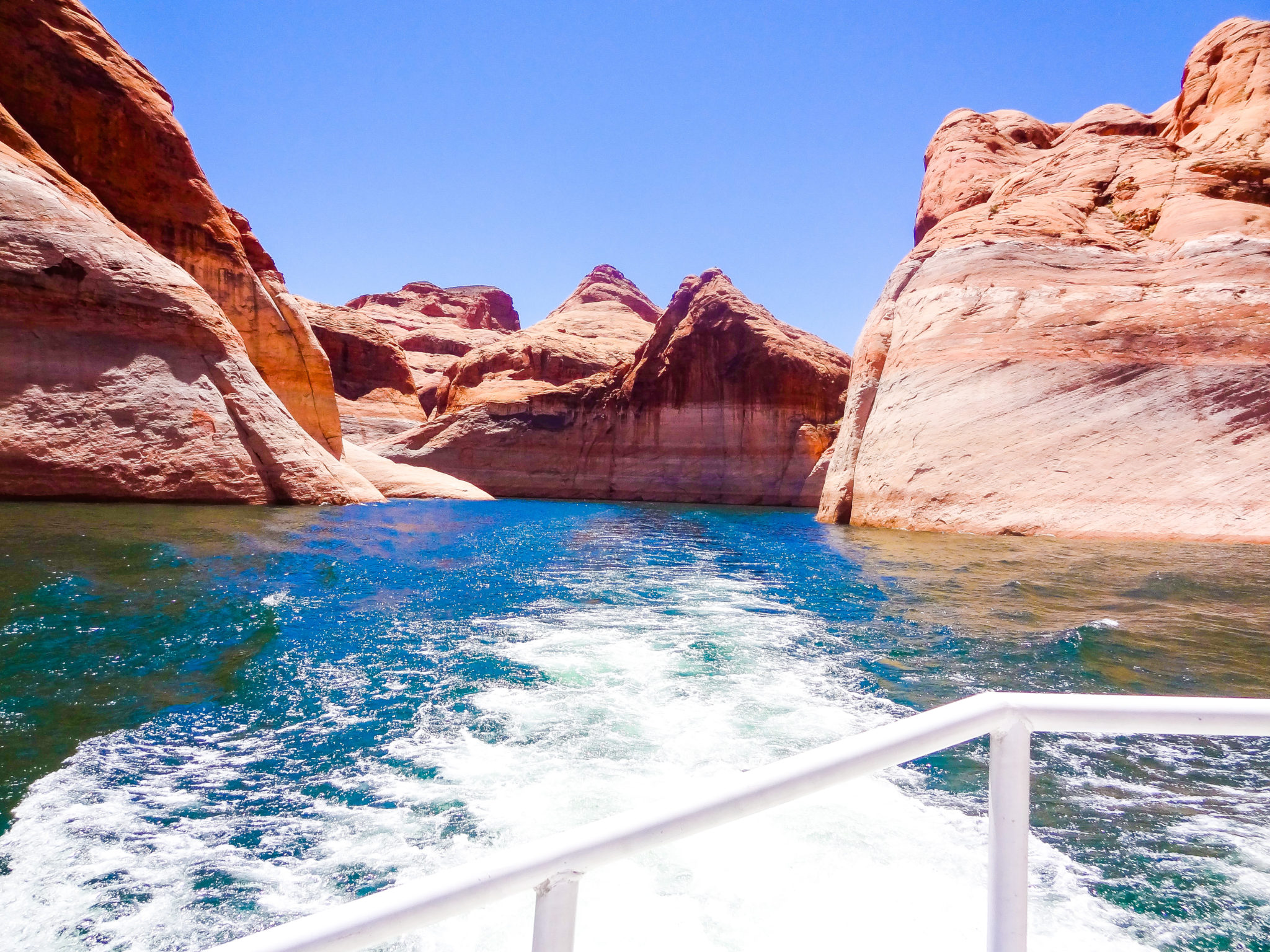


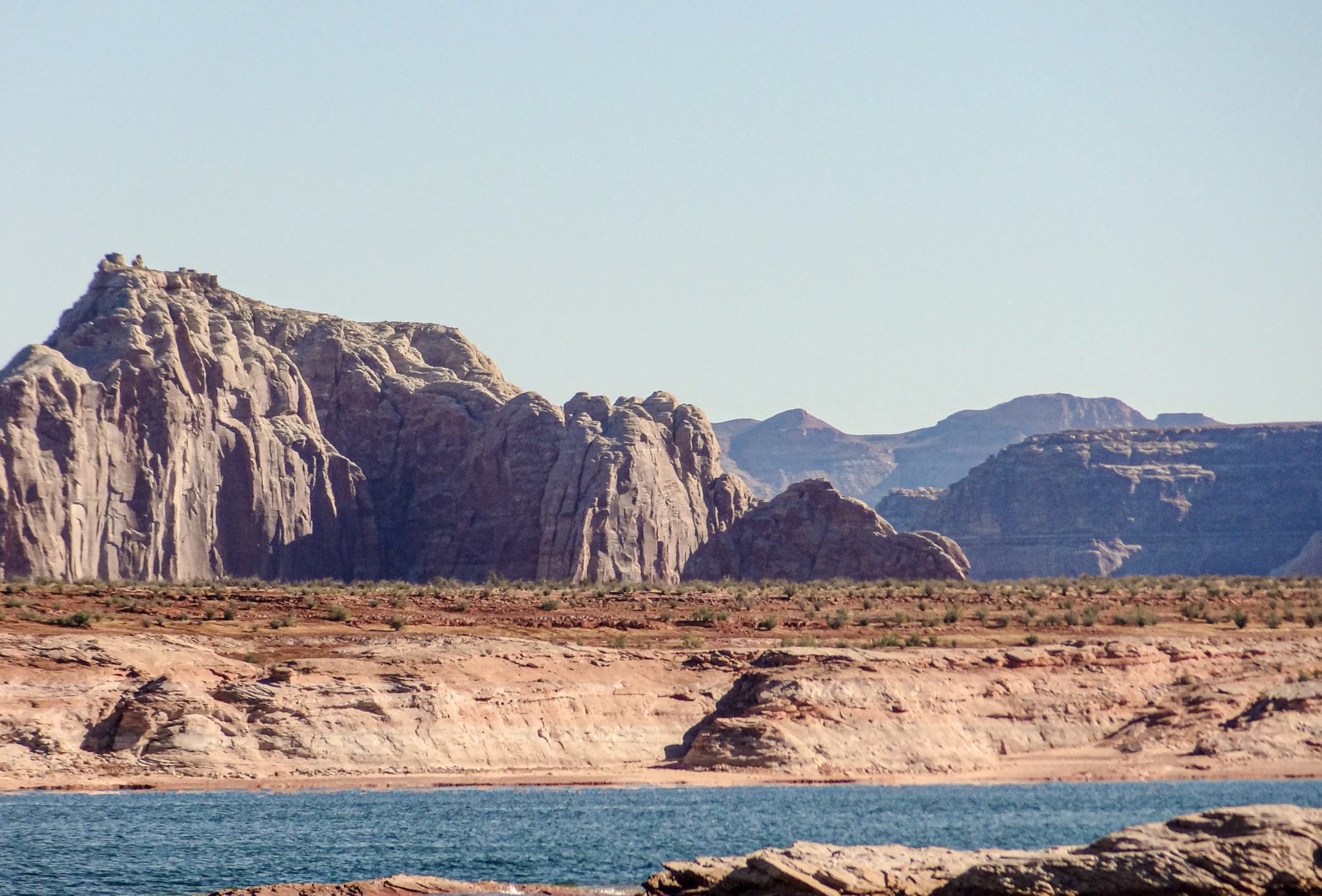


Hiking to Rainbow Bridge
Rainbow Bridge National Monument is a beautiful natural bridge soaring almost 300 feet into the air. This monument is located on Navajo land, and a permit is required to enter if you arrive on a private boat. The price that you pay for the Lake Powell boat tour allows you access to set foot on the beautiful and sacred land.
From where the boat stops, it is a mile or so hike back to the Monument. The hike is moderate – there is some incline and are places where you want to be sure of your footing. But exercising a little caution and common sense, you will find the hike manageable – even for a novice like me 😊.



It was hot when we visited, so this added to the physical exertion that we put out to get back to the monument. But the hike was sooooooo worth it! You can walk to the other side of the monument, but this should be reserved for those that hike quickly. The stop (including hiking out to the monument, and making it back to the boat) is only an hour or so in duration, so you want to make sure that you are efficient with the use of your time so that you can get to the Monument, be able to enjoy it for a few moments, and hike back.
Carl Hayden Visitor Center
After a day on Lake Powell, I was completely satisfied with Page, AZ. The boat tour was one of my all-time favorite park experiences for the relaxation and the things that I got to see and do. I didn’t want to leave the Lake Powell area because it was so beautiful!
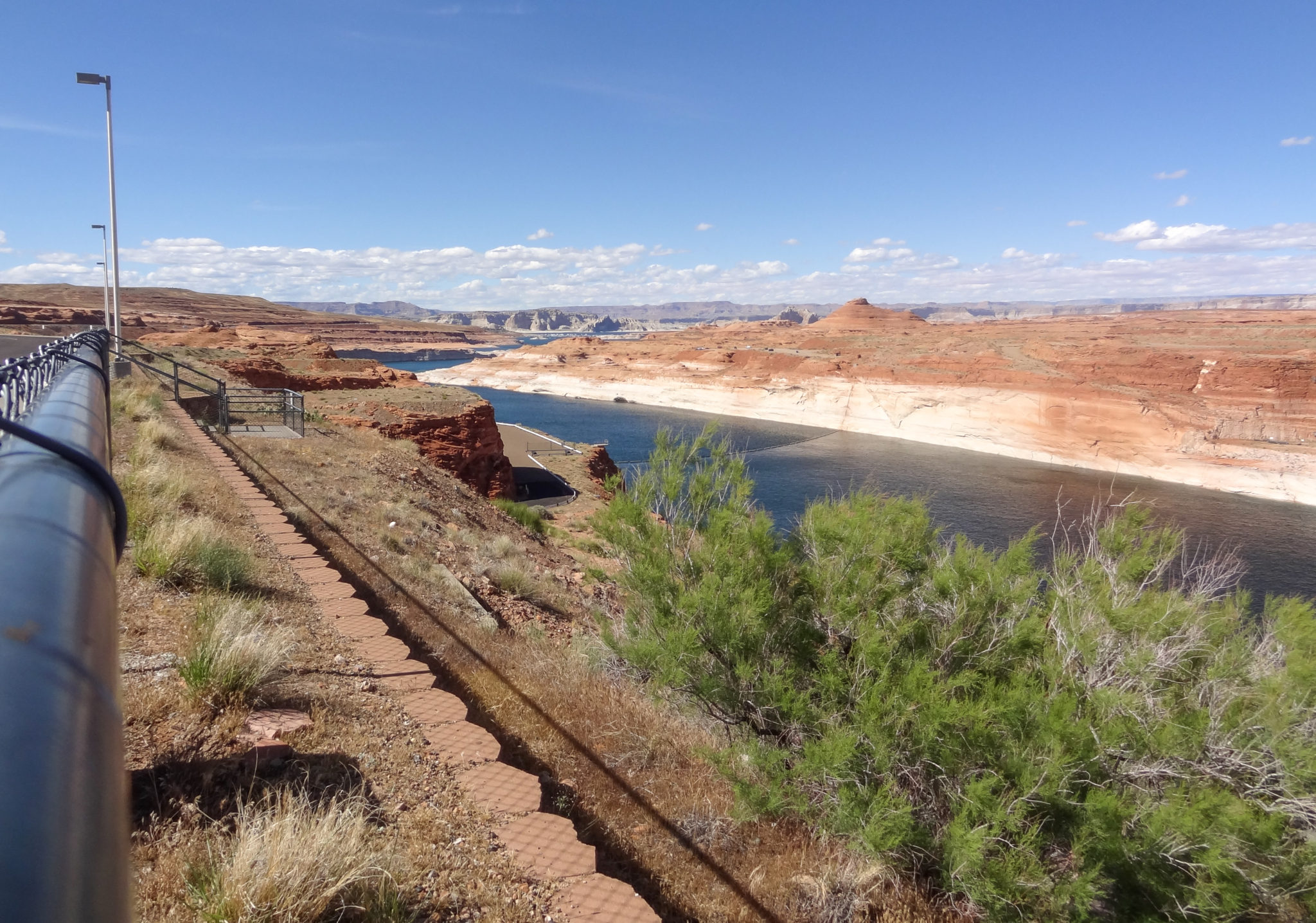


On the way back to our hotel, we stopped at the Carl Hayden Visitor Center to get our passports stamped. This was a beautiful Visitor Center that offered a variety of videos and educational experiences to visitors. You could also purchase tickets to take a tour of the Glen Canyon Dam which is adjacent to the Visitor Center. I originally wanted to tour the dam, but decided not to because I was pretty spent from our boat tour, and opted to visit Horseshoe Bend instead.
Visiting Horseshoe Bend
The iconic image of Horseshoe Bend presents just as it does in the photos – it’s simply beautiful! The one thing that I didn’t’ realize, however, was the sheer number of people making the trek to the site and doing dangerous and inappropriate things (like climbing on rocks that are clearly marked off limits – for a very good reason). I thought that the view was gorgeous, but it was a trek to get back there for me – perhaps because I was tired from the visit we had just finished to Rainbow Bridge, perhaps because I’m more out of shape than I care to admit.
We had to pay $10 to park due to new parking fees implemented by the city. We didn’t stay long at the site – just enough time to walk out, take a couple of photos, have a few mini panic attacks from some of the ridiculous things people were doing for their perfect Instagram shot, and walk back to our vehicle. Overall, it was about a mile and a quarter jaunt out and back (but it felt like more to me).
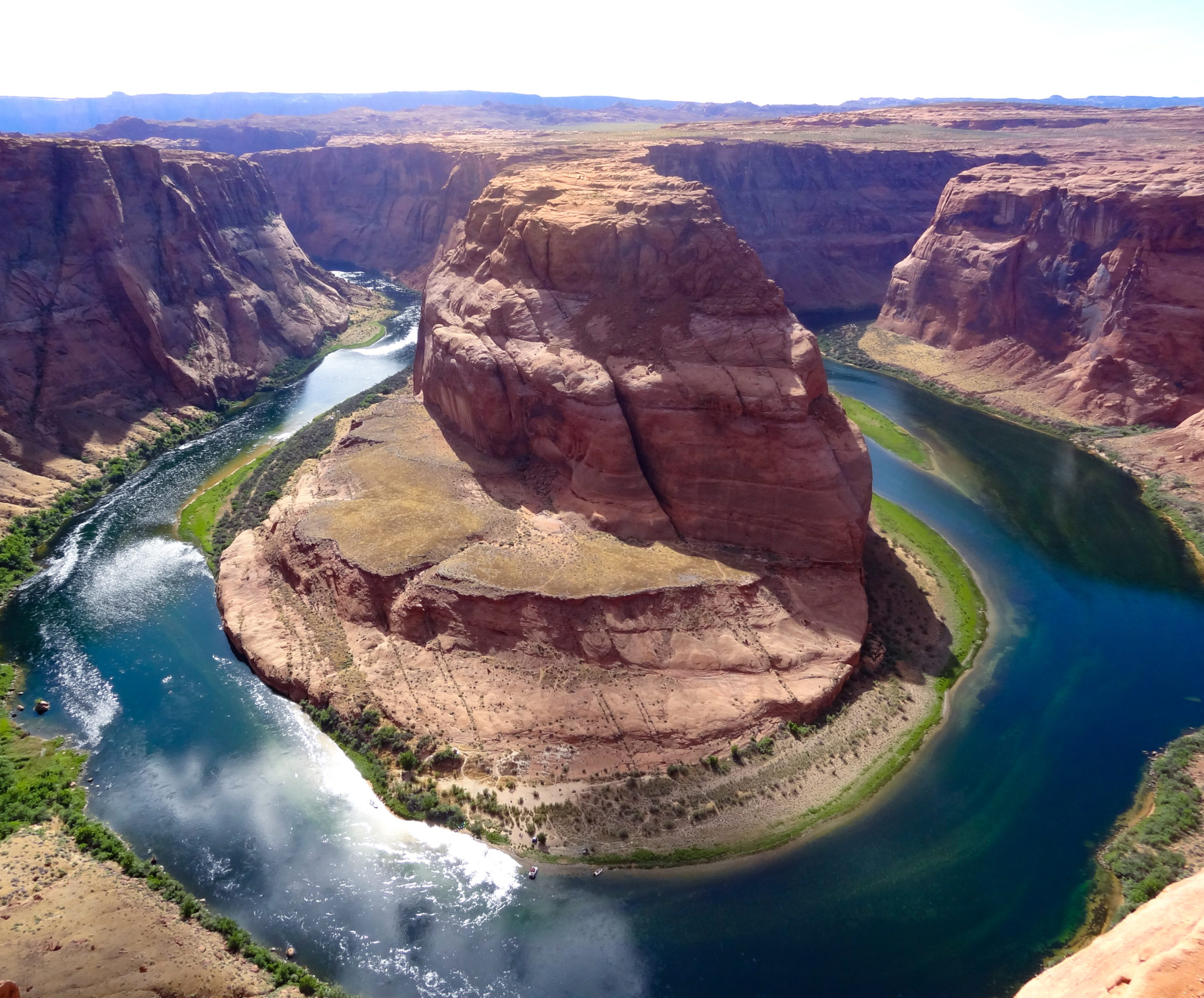


While it is a beautiful site, this is one that I would probably skip if I went back. If I had it to do all over again with the same time constraints, I would have opted to take in a little more of the views on the water by the Marina and maybe even look into doing a little bit of fishing.
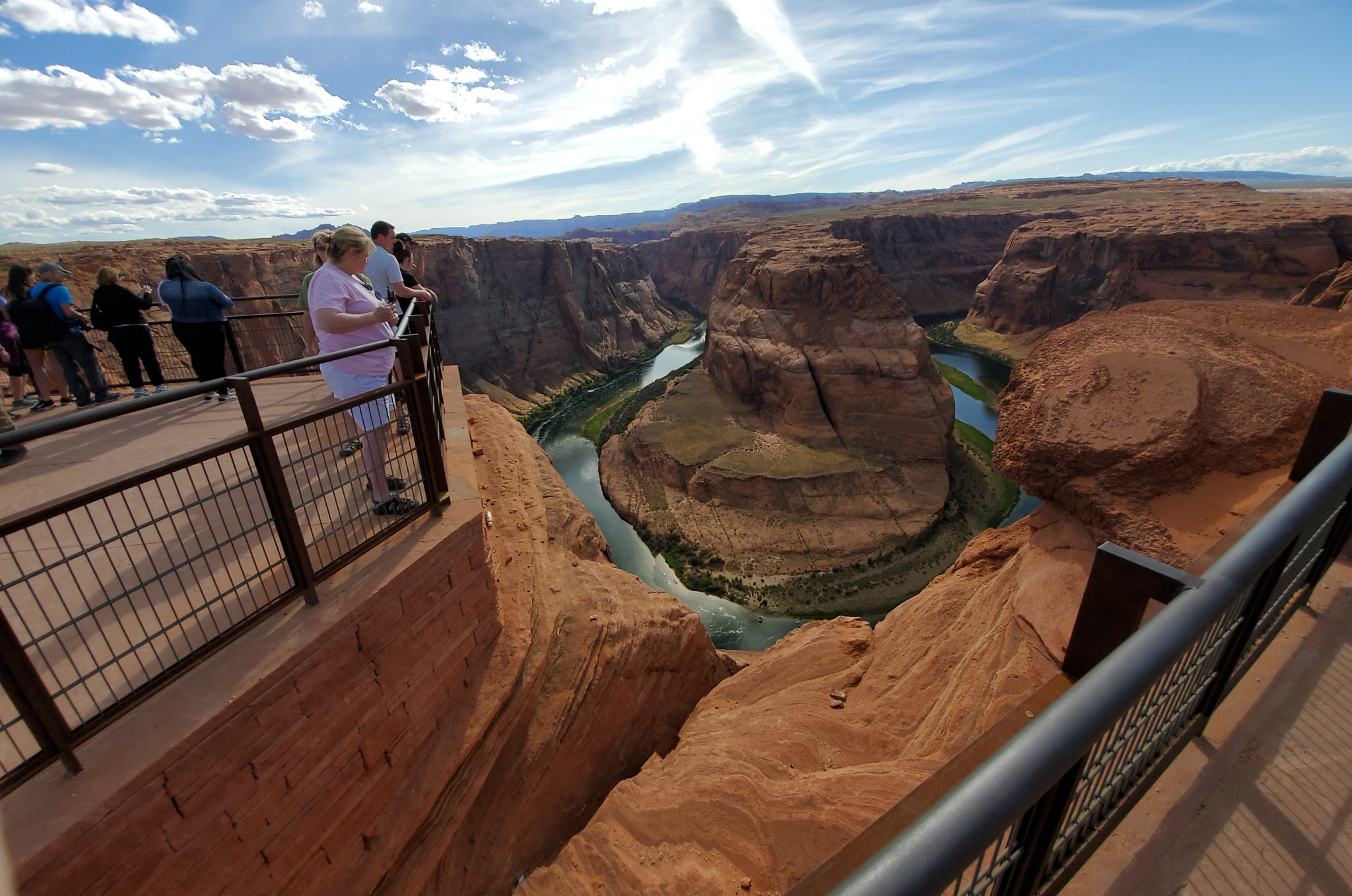


The one thing that isn’t captured in the photos is the sheer scale of what you are looking at. Water is certainly a powerful force as it is able to fashion the earth and everything on it!
Day 5: Grand Canyon National Park to Boulder City, Nevada
We rested for a second night in Page, AZ to arise for a trip that I had been anticipating for most of my life. We were getting up to go to the Grand Canyon!
Traveling from Page, AZ to the Grand Canyon
The drive between Page, AZ to the Grand Canyon was in the realm of 2 hours and 15 minutes in duration. Starting in Page, we drove through some beautiful country squarely in the heart of the Navajo Reservation. Seeing the abject poverty that was set among such a beautiful background was saddening though.



Some thoughts on gratitude – reflection from a conversation in Page
While I am only beginning to understand the history that led the Native peoples to reside in reservations in this country, I am quickly realizing the inequity that exists as a result of this history. Our leisurely road trip took on new meaning as I began to reflect on what our Navajo hotel attendant had told us just the day before. When learning that we would be journeying to Rainbow Bridge, he said that he hadn’t been there himself, but that he had always wanted to go. As a tourist making a quick pass through a place, it can be easy to overlook that often the people who live in these beautiful places may not have been able to make a visit themselves, even though these magnificent and awe-inspiring sites are in their own backyard.
Something must needs change to afford opportunities to access our parks and public lands – especially for the folks that live near to them. I am grateful – eternally grateful – for being able, having the means, the health, the flexibility to be able to make a visit and share the experiences of these great places. Hopefully over the course of learning more about some of the challenges that impact access to the parks, I can reflect and provide some exposure to these topics as well on this blog.
The Grand Canyon Desert View
We were so excited as we approached the Grand Canyon! After coming down quite a bit in elevation from Cedar Breaks and Bryce Canyon to Page, we were again embarking upon a climb. This time, the climb was not as much, but it was enough that by the time we had entered Grand Canyon National Park and exited our vehicle that the air had noticeably chilled and the wind beat us in squalls of terror. It was apparent that the shorts and t-shirt that were comfortable in Page would not suit us during our time at the Grand Canyon.
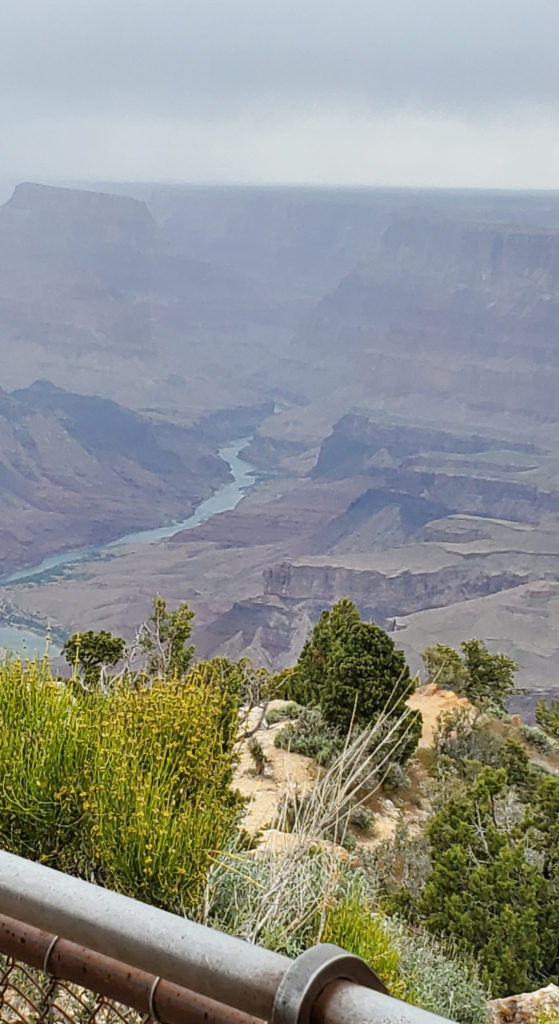


The Desert View area is a popular first stop when entering the park from the East to explore the South Rim. Therefore, I took the opportunity to change into long pants and a sweatshirt in the modern restroom facility before making the short walk to the Desert View overlook.
The view did not disappoint! After seeing the world from higher elevations, marching down the Grand Staircase, and boating and hiking through Canyons, it was a reflective experience to look down into the earth as it opened in a great crevasse in front of me. A river was running mute in the distance below – appearing small when compared to the masterpiece that it had whittled in the earth.
This is what I had been waiting for!
We took a few minutes to take it all in. We were clearly in a paradise beyond the construction of man. Even the fog that began to settle in was beautiful as it painted a sheer veil over the unadulterated land below. The wind, the cold, the increasing haze could not disturb the image below. Knowing, however, that we had more ahead of us, we left our overlook – returning to the car just as the first of the sleet hit our windshield…
Sleet and Snow on the Grand Canyon
The sleet quickly turned into snow, and the light fog that decorated the Desert View with a luminous haze visibly thickened the air around us until a matter of minutes it was as if we were traversing a canyon filled with creamy, white roux.



Grateful that we had been able to see the overlook at Desert View, but disappointed that our Grand Canyon experience was not going to deliver for us the title of that singular place on earth where you reflect upon to conjure up a concrete image of “peace”, we sought out the things that we could do in order to mark our Grand Canyon experience before moving on to our next destination.
These things included:
- Visitor Center to get our stamps and view the park video
- Visiting the Bookstore to get some gifts
- Drive to Grand Canyon Village and seeing elk grazing on the side of the road
Despite the less than optimal weather that we experienced, I am still so grateful that we had the opportunity to visit this magnificent park.
While we didn’t stay overnight at the Grand Canyon on our trip, when we visit the next time, we will look to stay in the Grand Canyon Village due to its location within the park.
Pro Tip: One thing that I have learned while on the road is to go with the flow. When traveling according to a schedule that I impose, I cannot expect for nature to cooperate all of the time 😉. This is the reason that I believe that flexibility while traveling is such a valuable thing as there are always alternative ways that you can spend your time in a place.
I’m not giving up on having that “travel hallmark” of a Grand Canyon experience though – it just might have to come during my next trip out west.
Drive from Grand Canyon to Boulder City
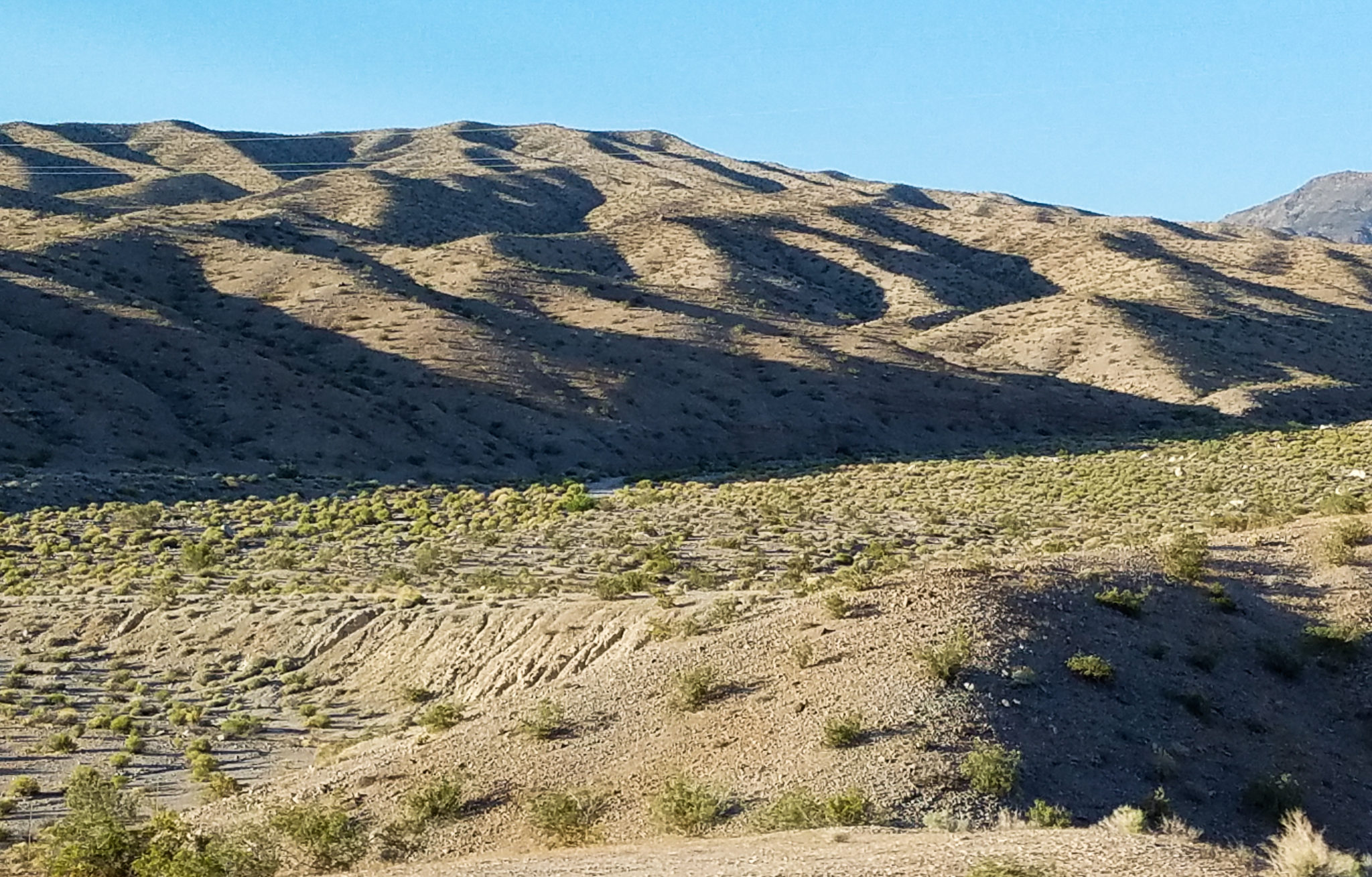


When we left the Grand Canyon, the weather changed from snow to sleet to rain and then to gray skies. Our visibility increased, and we could see more of the beautiful landscape that is naturally what I think of when I dream about the west. Driving alongside the historic route 66, we approached Boulder City – home of Lake Mead and the famous Hoover Dam.
Staying in the Boulder Dam Hotel in Boulder City
Did you know that the Hoover Dam was once called the Boulder Dam? I certainly didn’t know that. This was just one of the many things that I learned in the Boulder Dam Hotel, an historical hotel in Boulder City that housed many of the workers that built the world-renown Hoover Dam. In addition to being a central site in the cute area of Boulder City, the Boulder Dam hotel boasts a nice museum containing artifacts from the creation of the Dam as well as some of the famous guests that stayed in the hotel.
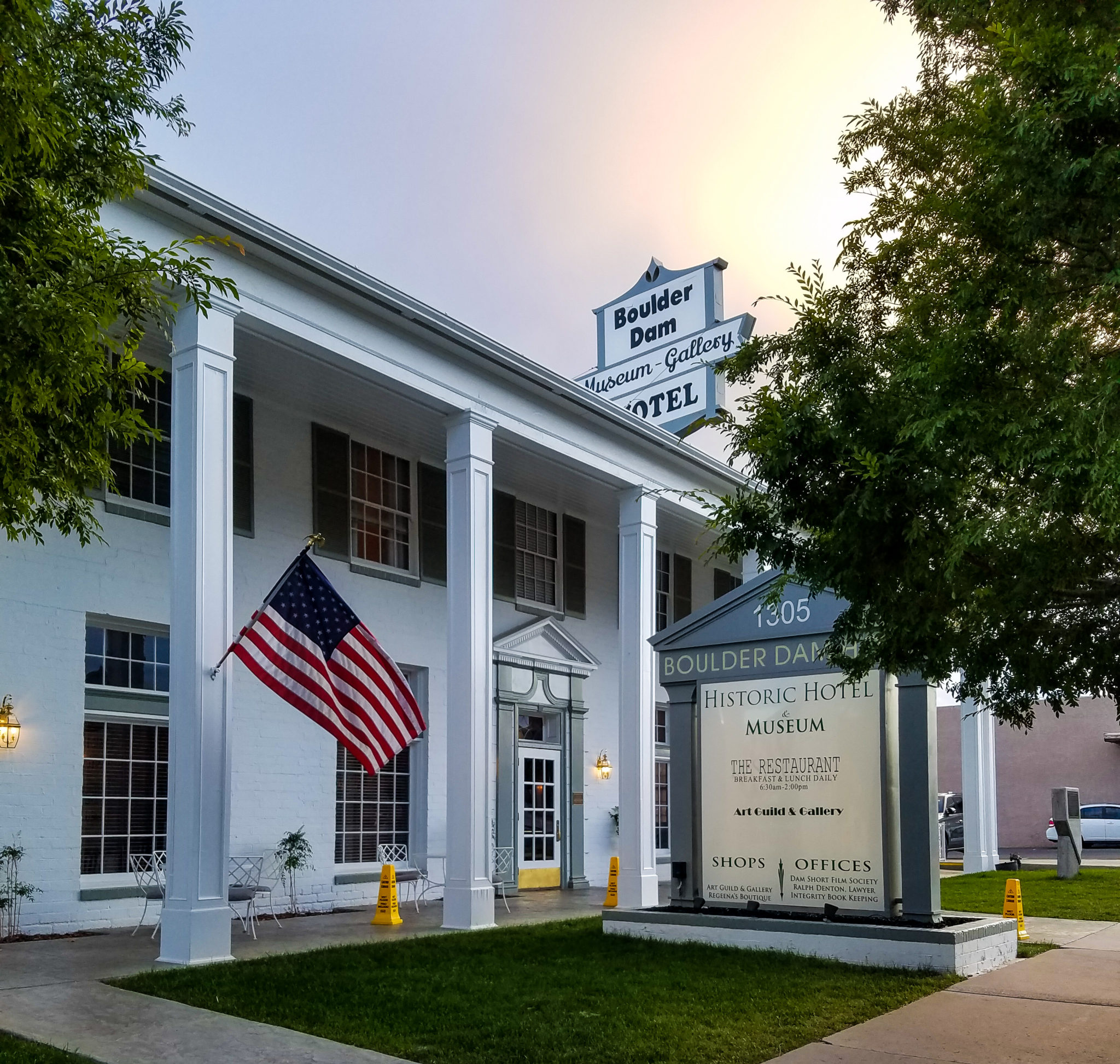


We enjoyed our stay in the Boulder Dam Hotel, complete with a lovely breakfast in the beautifully renovated hotel restaurant. We also loved the proximity to other places to eat (we got our grub on at the Dillinger Food & Drinkery for dinner), and enjoyed the walkable area surrounding the hotel which hosts some beautiful and fun public art.
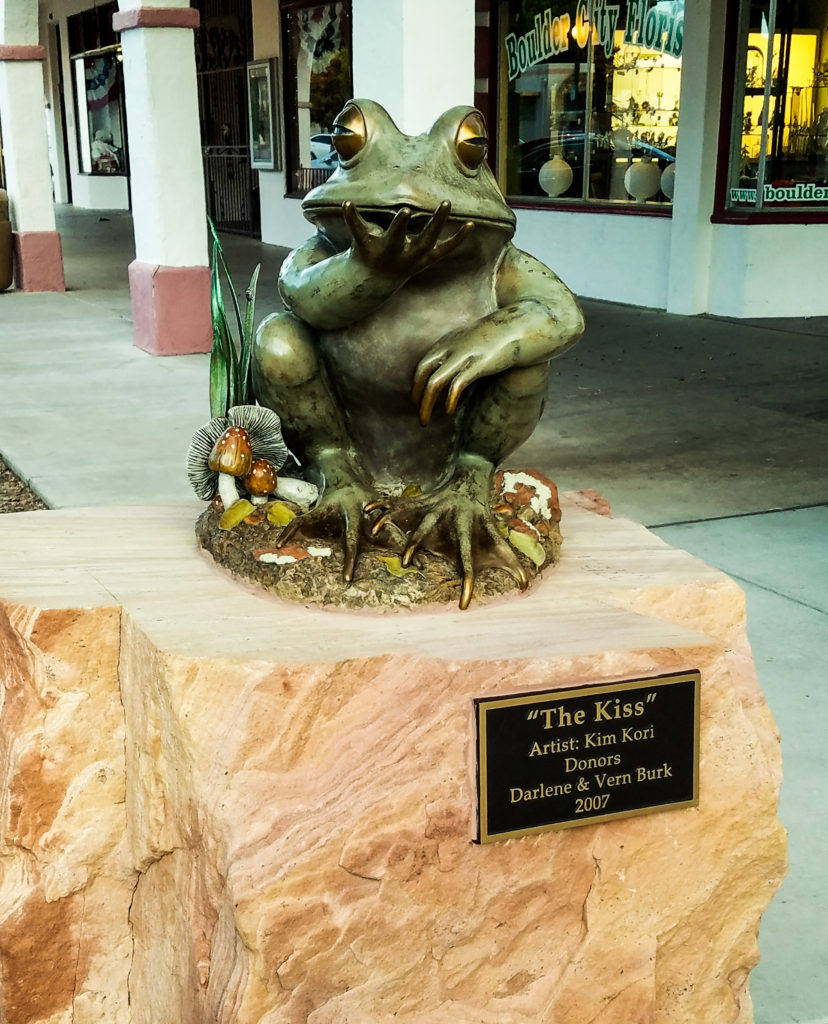


Random Life Reality on the Road
At this point in our trip, we were tired – five solid days of travel, sightseeing, hiking and tours made for two tired travelers! Knowing that we like our down time on our trips as well, we planned to arrive in Boulder City earlier in the day instead of pushing it into the nighttime. This was in part due to our desire to get some good rest before continuing our journey, and partially because we didn’t want to be greeted by Game of Thrones spoilers the next day. After all, our fifth day coincided with the series finale!
Knowing that we wanted to see the finale, our packing list included our Amazon Fire stick. It was a “fun” (not so fun) challenge to remember the password to the HBO app that we were subscribed to, but once we did, we got to watch the end of the series that we had waited on for years!
One cool thing that the Boulder Dam Hotel had in our room was a white noise machine. I had never used one of those before, but I loved it! I turned on the thunder and lightning setting, cracked the window in our bedroom to allow in the fresh air, and about five minutes after Game of Thrones ended however, I was sound asleep.
Day 6: Hoover Dam, Lake Mead, Tule Springs and Death Valley
Breakfast in Boulder Dam Hotel was amazing! The dining room on the street level of the hotel boasted an elegant, historical atmosphere. It was clean and serene! We ate breakfast while ooooohing and aaaaaahing over the exposed brick and beautifully restored windows that were meticulously installed. We felt like early 20th century royalty.
After all, we were staying like the visitors did back in the day!
Visiting Lake Mead National Recreation Area and Hoover Dam
Because of its proximity to Las Vegas, Lake Mead NRA is one of the most frequently visited National Park units close to Las Vegas. Hoover Dam makes it on just about every Las Vegas bucket list, and for good reason! If you’re visiting National Parks close to Las Vegas, it definitely deserves a place on your “must visit” list.
We checked out of the hotel to make our way to the Visitor Center that was in the middle of town. I didn’t realize it, but there are several Visitor Centers associated with Lake Mead National Recreation Area. The Boulder City Visitor Center located within a block or two of the Boulder Dam Hotel is nice, and you are able to get the same stamps for your passport here as you do in the main Alan Bible Visitor Center.



We went to Hoover Dam and stared in awe at the depressed water levels. This was truly terrifying considering that the Dam supplies water to the region including northern Arizona and southern Nevada. Water levels are lower than historical because of urban development in Vegas and points north. This is concerning because of the real implications that it has on a very real human and natural environment.
We went to the primary Alan Bible Visitor Center and watched the park video that highlighted the Lake Mead Recreation Area, and walked around the grounds, enjoying the waddle of quail and the diverse cacti that decorate the landscape around the Visitor Center.
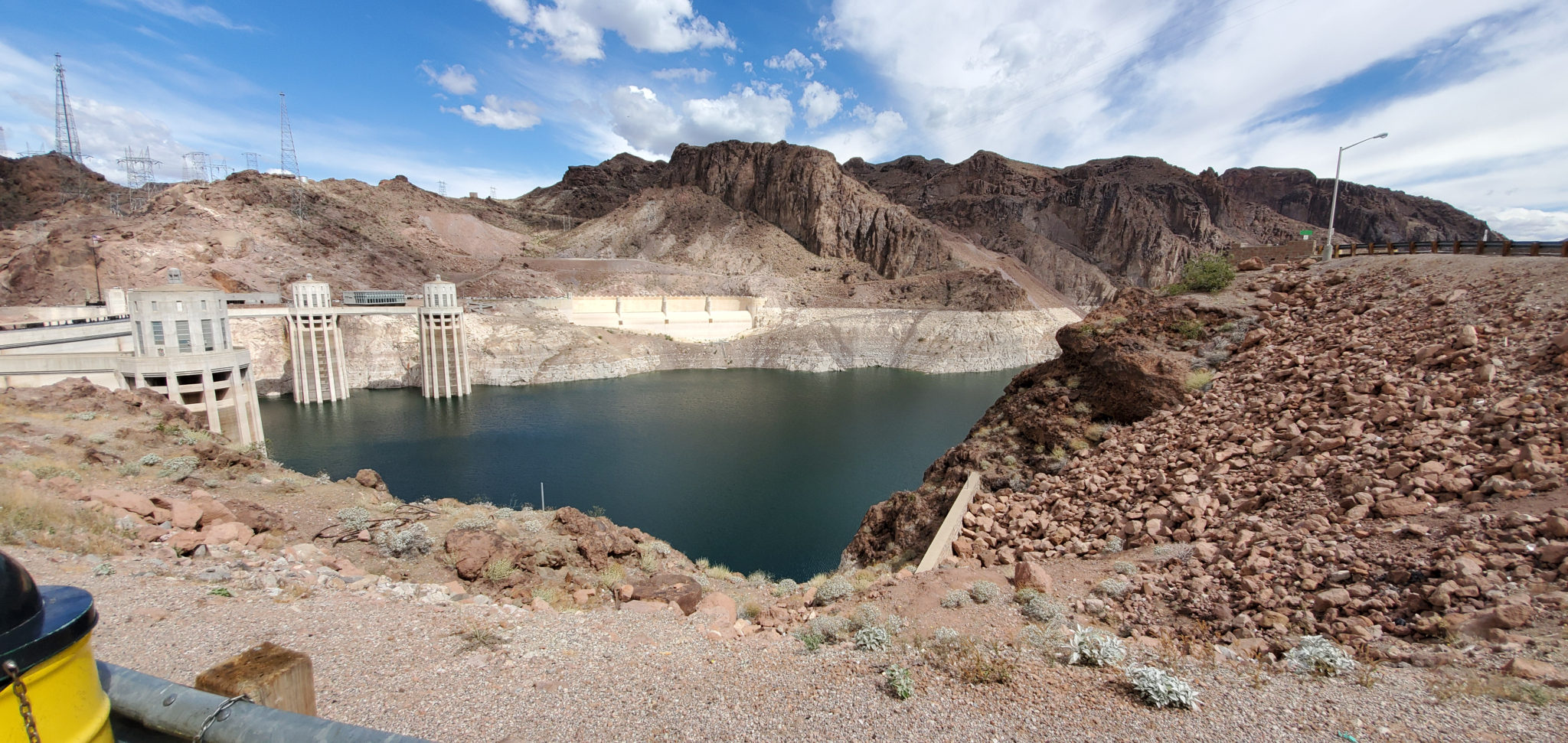


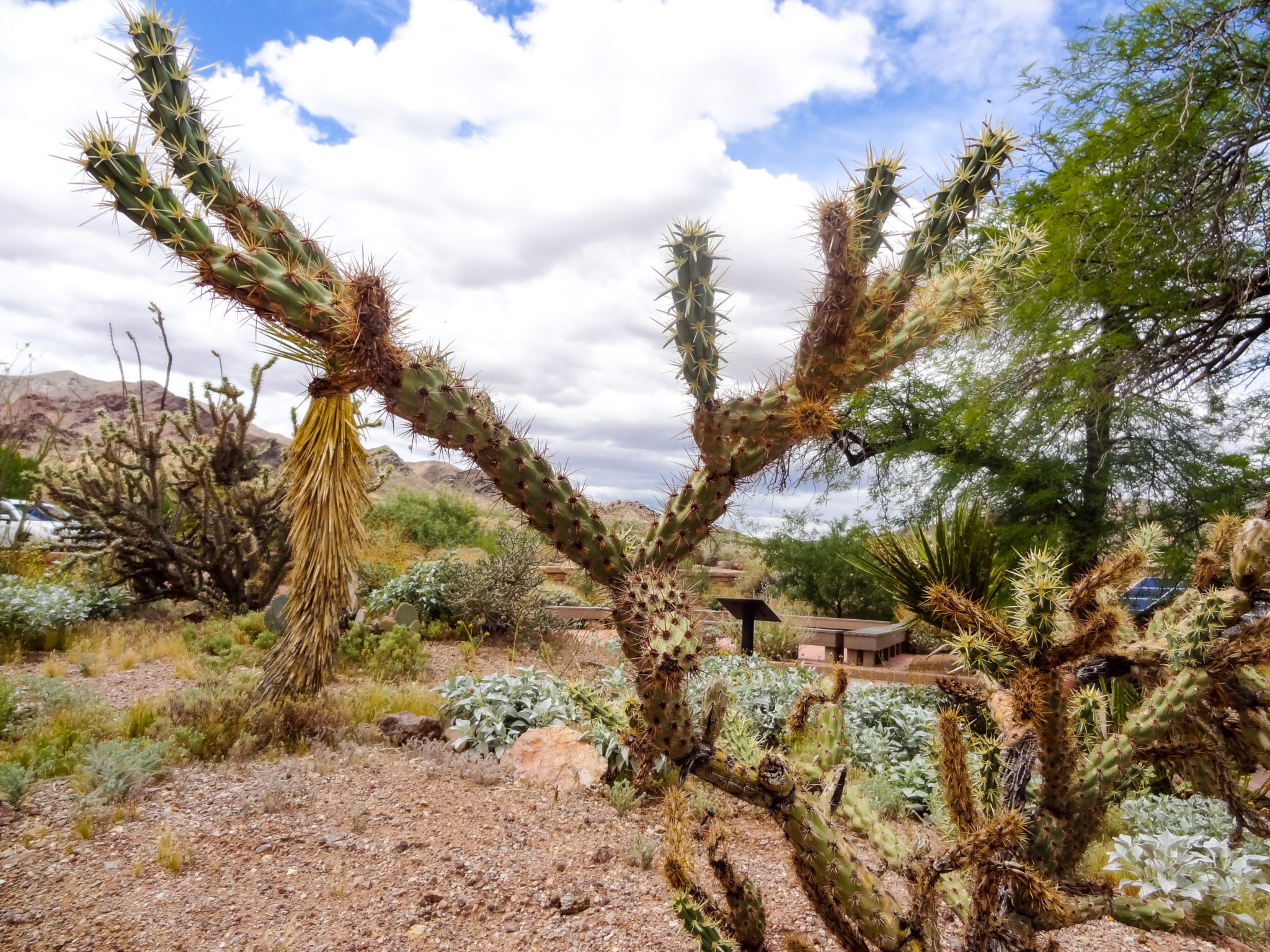


We then set off for Tule Springs National Monument in route to Death Valley National Park, our final parks to visit on our road trip.
How our road trip from Las Vegas takes us back to Las Vegas and out again
I was happy that the Lake Mead Park Ranger had prepared us for our visit to Tule Springs and told us to look out for the neighboring “Floyd Lamb Park”. I would have been otherwise confused as to whether we had arrived or not. Tule Springs is located adjacent to a sprawling suburban exit at the northwestern end of Las Vegas.
Visiting Tule Springs Fossil Beds National Monument
The parking for the site is literally “the end of the road”. It is a newer park that protects over 22,000 acres, established to protect paleontological findings from the Ice Age.
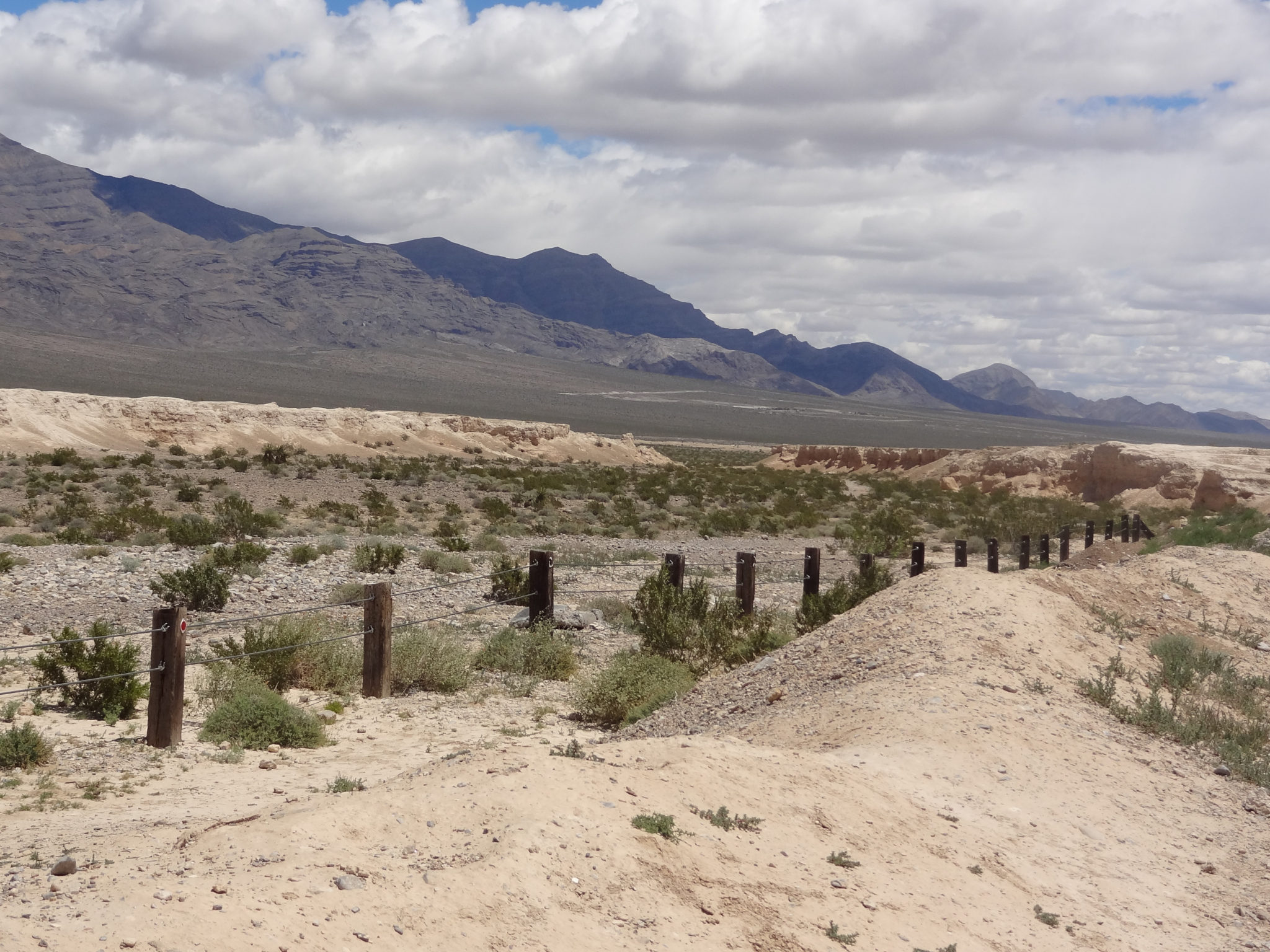


There is no Visitor Center here (we collected the Tule Springs passport stamp at the Lake Mead Visitor Center). At this time, only a small sign marks its existence. It is a beautiful end to the sprawling desert-metropolis that is Las Vegas though. Visiting this site makes me question how many other natural and historical discoveries have been obliterated through the human impact of development (in Vegas, and elsewhere for that matter).
We only stayed at Tule Springs Fossil Beds for a few minutes before hitting the road. Next stop, Death Valley National Park!
Driving to Death Valley National Park
Driving to Death Valley National Park was somewhat boring when compared to the rugged but distinctly perfect landscape that we had been driving through in southern Utah for most of the trip. But as we drew closer to Death Valley, the park known for its oppressive temperatures, unforgiving desert and, well, death, what was a relatively flat and long horizon began to become clouded by interesting, dry crusts of earth.
It’s easy to get spoiled when visiting the National Parks around Las Vegas!
Arriving at Death Valley National Park
While we had experienced snow in the Grand Canyon only the day before, Death Valley blasted us with (a mild) 90+ degrees that seemed to radiate up from the earth and rain down from the sky both at the same time.
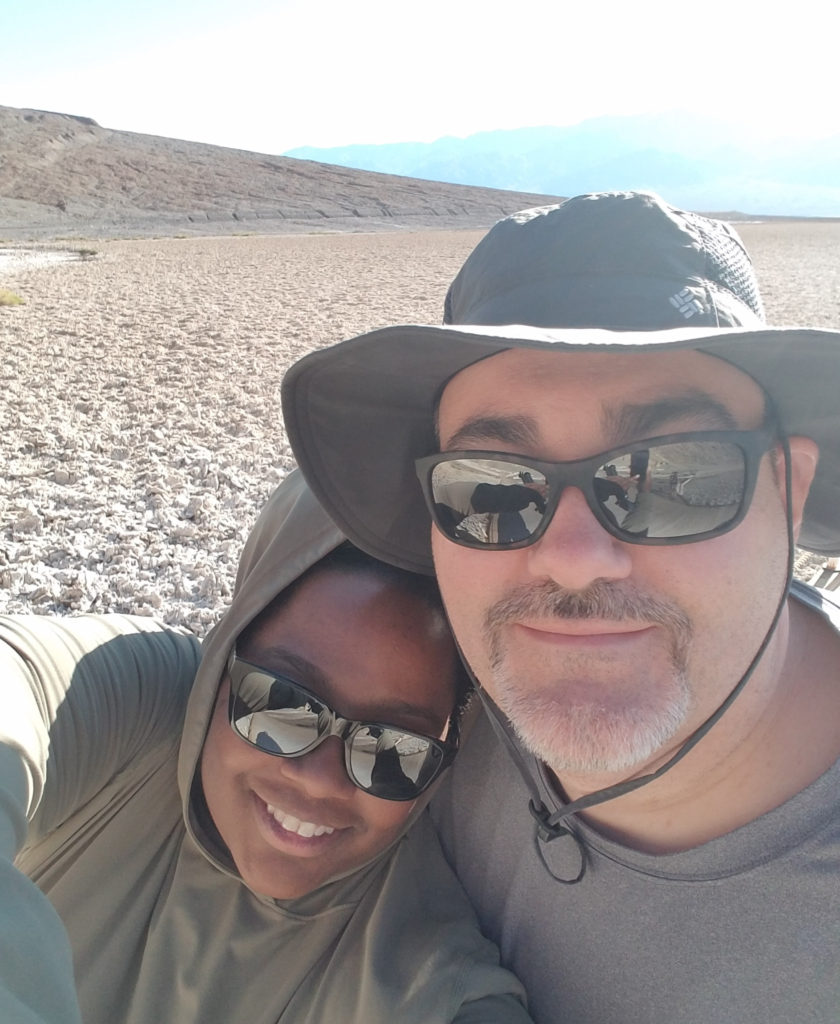


We went to the Visitor Center, a welcoming escape from the hellish temperatures, and were more than happy to collect ourselves as we watched the park video in the nicely appointed theater. The part of the video that once again stuck in my mind was the section that was done on the Timbisha Shoshone Indian Reservation.
The Timbisha Shoshone Indian Reservation is located in the park, not far from the Visitor Center. In fact, we passed by the entrance to the reservation on our way to the Visitor Center. In the doldrums of the sand… it was the land that they had as their birth right and remained to care for it even through the harshness both of history and of nature.
What to do during a Death Valley Day Trip
Even though Death Valley was the last park that we visited on our road trip from Las Vegas, it makes a great day trip for folks staying in Las Vegas as well! Here are some ideas to make up your Death Valley day trip (also check out our Death Valley in One Day post)!
We entered the park after driving from Tule Springs in Las Vegas via highway 95 to 374. We stopped to take the obligatory park sign photo, and stopped at Zabriske Point. At Zabriske Point, we walked up a paved incline to a beautiful overlook before pressing on to the Visitor Center.
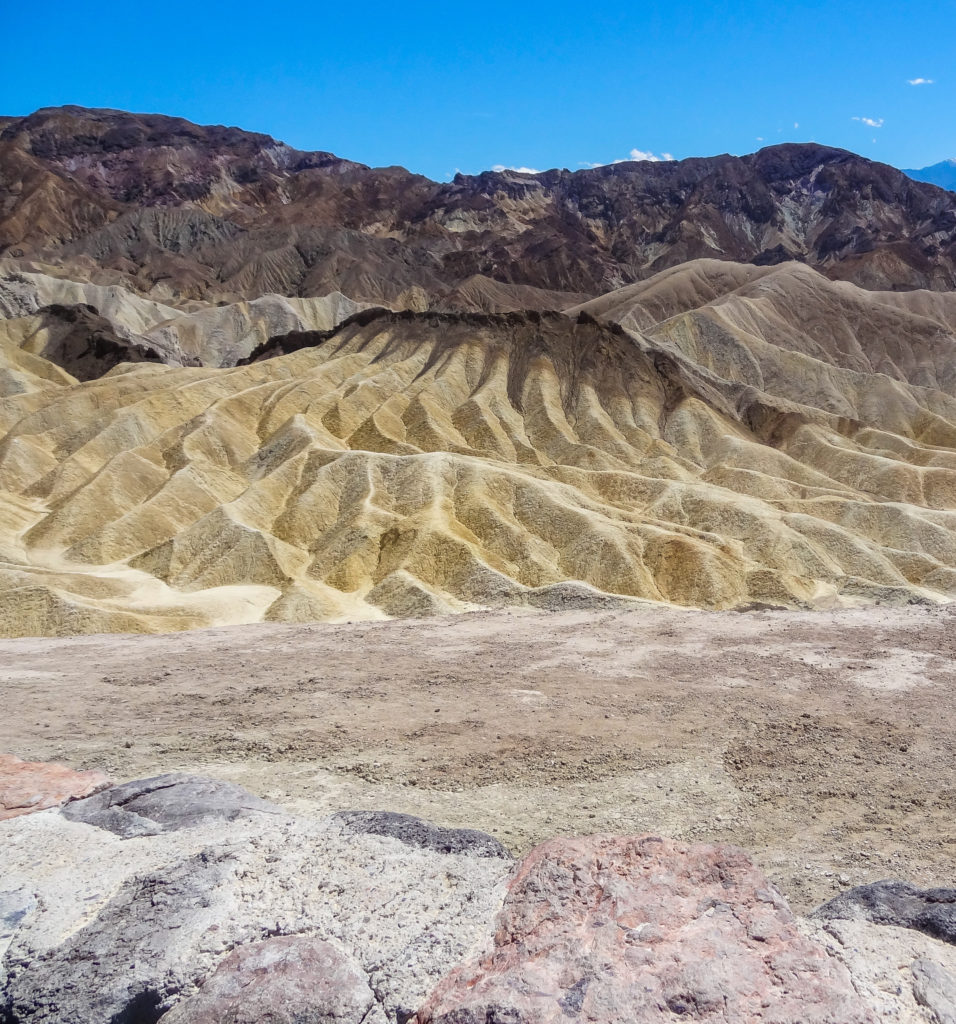


Once we left the Visitor Center, we drove out to the Mesquite Sand Dunes. Luckily (for me at least), we arrived there late enough in the day so that we didn’t have to worry about sidewinder snakes making waves in the dunes which we were told occurs mostly in the earlier hours of the day. I know that Jason wanted to see them, but I was grateful that our entire road trip out west was snake and tarantula free!
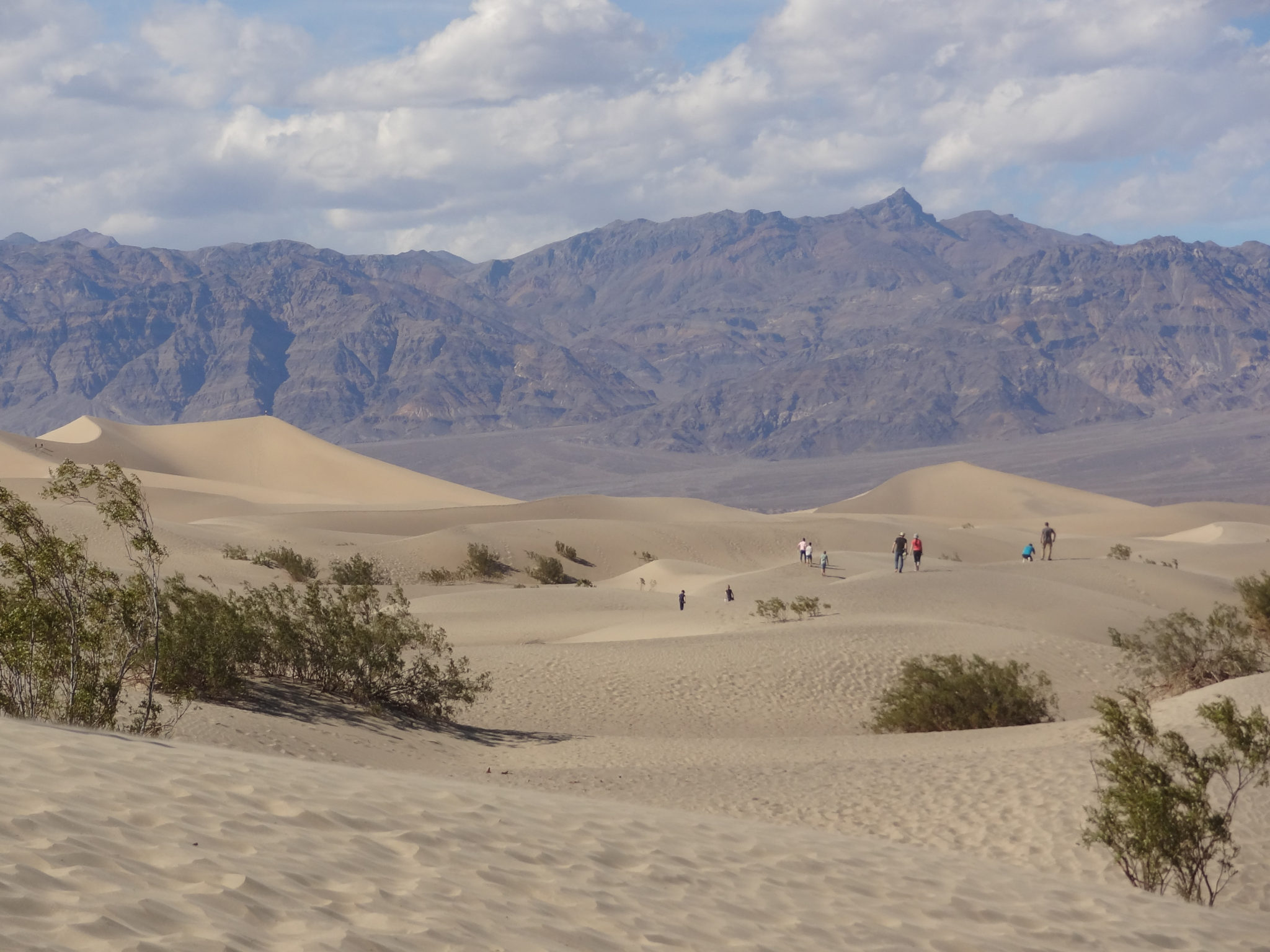


Driving back along the same road that we came (past the Visitor Center), we drove out to Badwater Basin and experienced the lowest point in the U.S. at 282 feet below sea level. It was horribly hot here – I have read recommendations to visit this spot earlier in the day, and for good reason! Nevertheless, the expanse of land, oppressed by heat and arid conditions sparkled with a magnificent beauty. Nothing in this beautiful creation was put in place without purpose!



The final site for the day was the Artists Palette loop which we had passed on our way to Badwater Basin. This gorgeous drive took us through chocolate mountains, and back to the colorful mineral-rich rock for which the scenic drive got its name. Before us, the mountains bore colors from deep dark chocolate to minty green, and melted from sugary tan to plum purple.
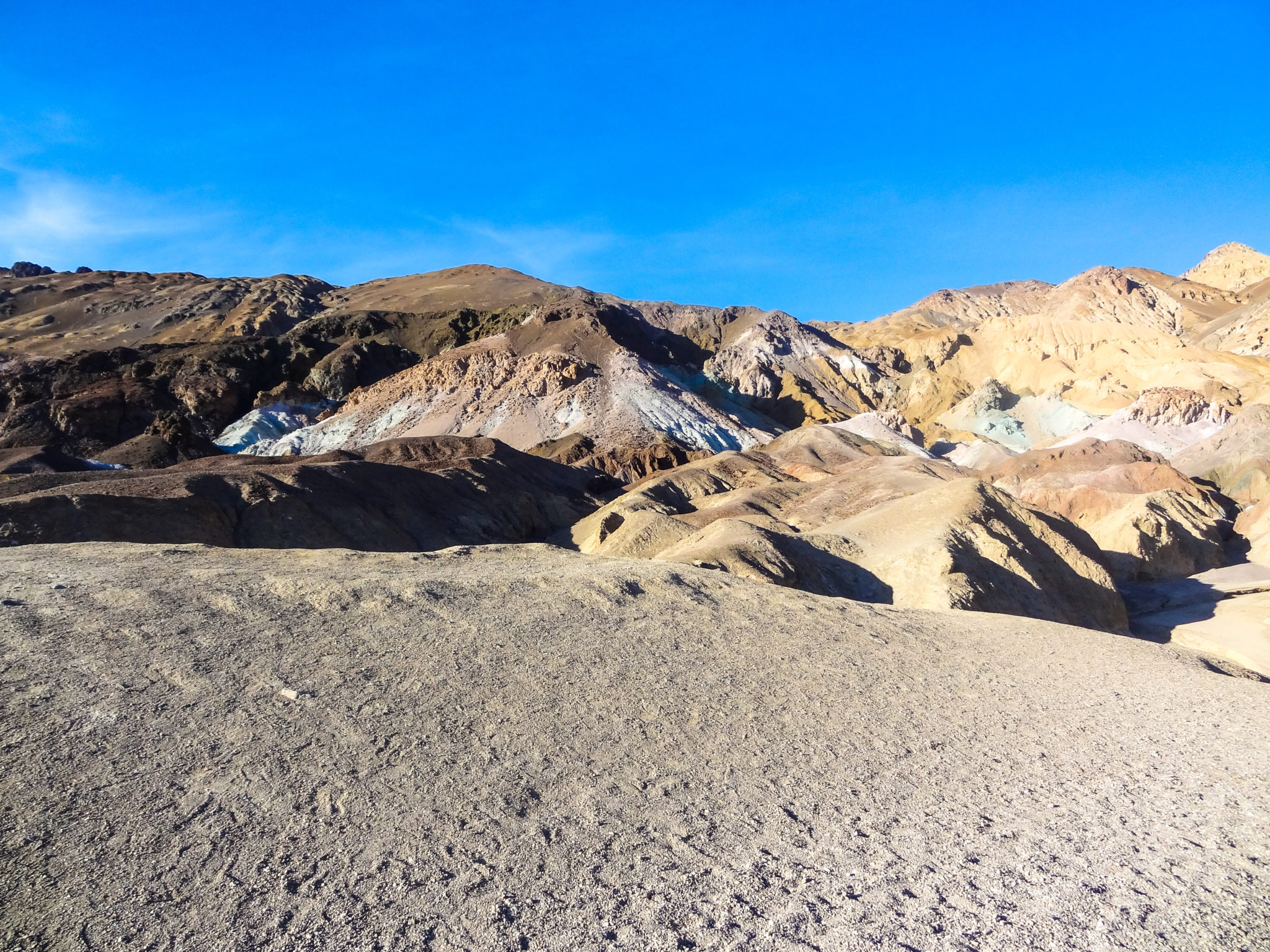


I loved getting to visit Death Valley, and see how – despite its name – it can make a visit one filled with vitality and fun!



Reflecting on the National Parks near Las Vegas
As we drove back to Las Vegas where we would spend the last few days of our vacation on its famous strip, I started to reflect on a few things that I was feeling over the course of our road trip. A few high-level themes are outlined below.
Gratitude
We had a beautiful trip, and were grateful for making our way in safety and comfort! I was grateful for having had the opportunity to see so many beautiful landscapes and to get to spend time with my best friend (and husband, Jason).
We were also grateful for having the resources to make the trip! After seeing several instances of poverty, I was reminded of just how lucky we are to be able to afford the luxuries that we do.
One thing that you might consider if you make a similar trip – when we started our road trip, we went shopping to get some road trip necessities like a cooler, some food items, a pillow and sheets, etc. that we did not carry with us on the plane. Once we returned to Las Vegas before returning our rental car, we donated the items that we didn’t consume to the Las Vegas Rescue Mission that serves the local community. This and other worthy organizations can use the help of visitors that have excess to give.
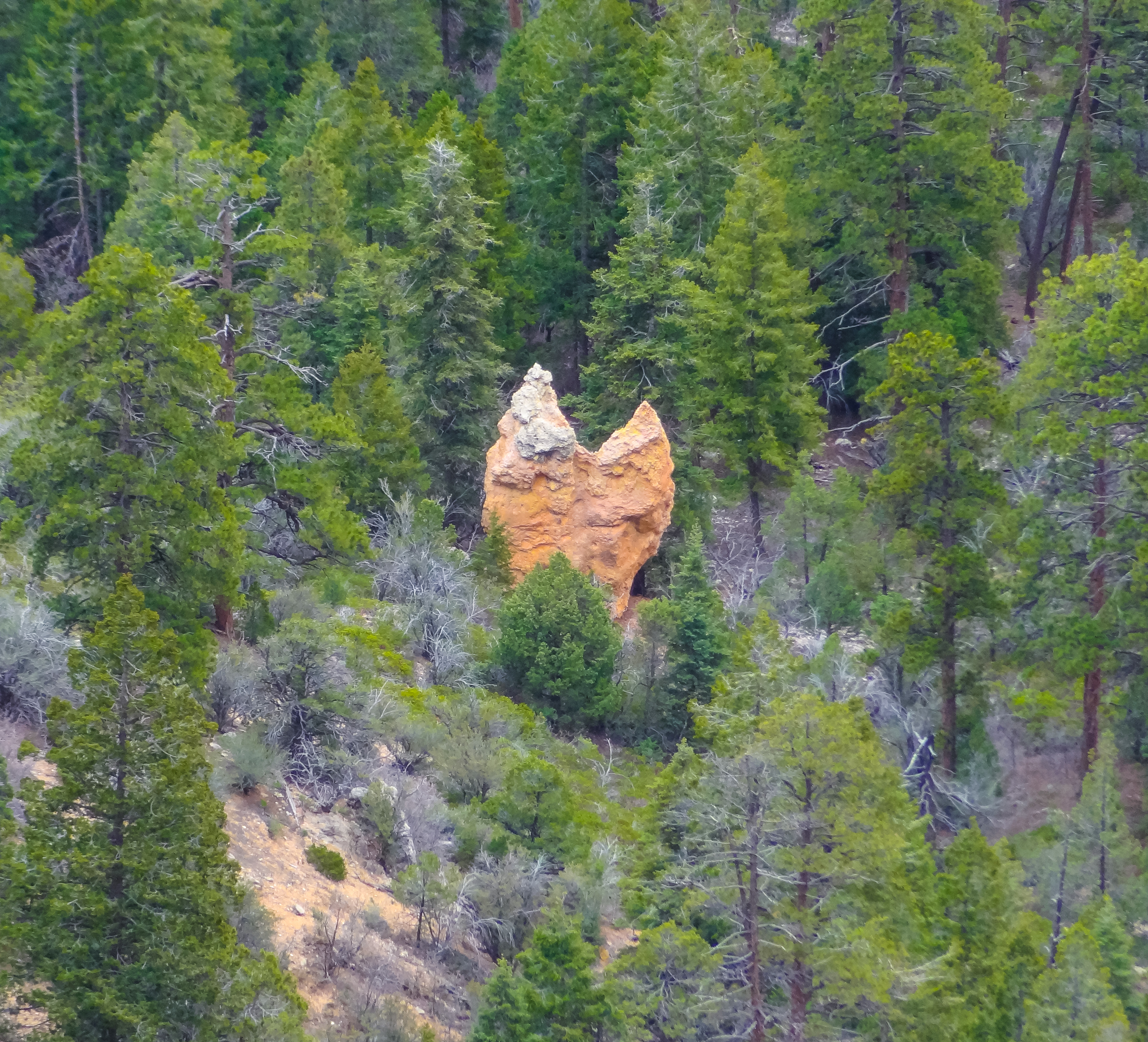


History and the Meaning of Place
I appreciated getting to learn about the Indian tribes that called these lands home. Place takes on a lot more significance when taken in the context of history. While I still have a lot to learn, I developed an appreciation for the love of ones home and the varied reasons that people live and stay in the places that they call home.
What constitutes a Visit and the difference between Vacationing and Visiting
I did a good deal of thinking about the difference between vacationing and visiting on this trip. Specifically, what does it mean to visit a place and how does it differ from taking a vacation?
There is intention and meaning attached to seeking out places with the intention of visiting and learning (i.e. making pilgrimage to Holy Lands is a ritual of visitation, not vacation).
On this road trip, I felt as if I were visiting instead of purely vacating my normal routine for the sake of a vacation. I’ll develop this line of thinking a bit more in the future, but for now, it’s something that has been on my mind that I thought that I’d share.
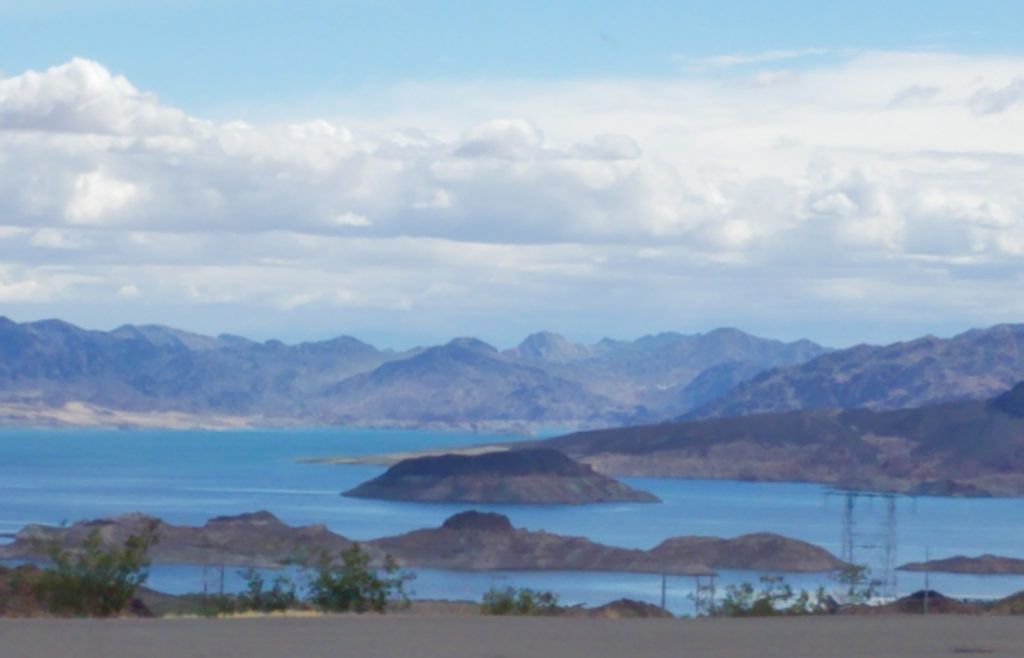


The west is beautiful!
Previously, our National Park travels took us as far west as South Dakota’s Black Hills and Devil’s Tower in Wyoming. This trip took us even further out. The scenery is quite different than it is in the Midwest, and has an abundance of charms. There are so many National Parks near Las Vegas, you really can’t go wrong with taking the time to visit them.
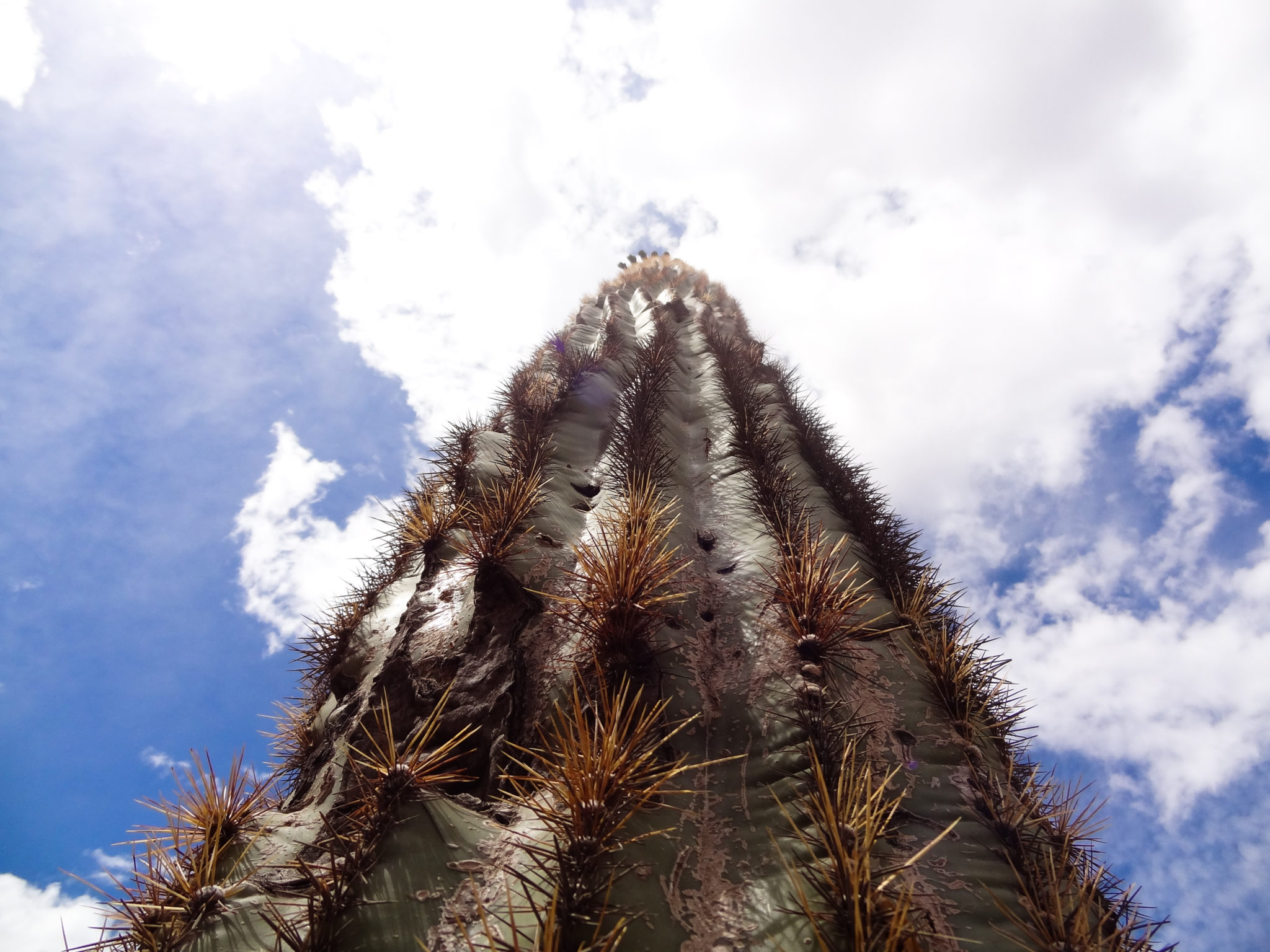


A few considerations for a National Park Road Trip from Las Vegas
Cost Saving Measure: America the Beautiful Interagency Pass
When you map some of the legs of this trip (using Google Maps), you will read that portions of the roads contain tolls. Please note that the tolls that are referenced are park fees for entrance into the National Parks. If it makes sense, you can purchase an America the Beautiful Interagency Pass prior to your visit or in the parks that you visit which can save some serious cash!
There are also other public lands, not managed by the National Park Service that you can visit near Las Vegas. Your pass will work in these places as well.
McCarran International Airport – Picking up your Rental Car
Las Vegas’s McCarran International Airport was our jumping off point. I can personally attest to the fact that Las Vegas is a great place to fly into in order to see some of the most gorgeous places on the planet!
The airport is very large, but overall easy to navigate. We did have a moment of difficulty, though, when we found ourselves not completely sure how to get to our rental car. We learned that the rental car facility is a few miles from the baggage claim. Here’s a site that should help you figure out where to go when you visit.
This itinerary is possible – but note that we had two drivers
I have seen in some threads on Facebook that solo travelers want to pursue trips that are similar in length and intensity to this road trip. I think that if I were driving 100%, I would stretch this national park itinerary from Las Vegas out over more time or cut out some of the stops. Don’t drive while tired, and know your limits 🙂 Safety first!
Note: any of these experiences can be part of a much longer and deeper itinerary or can make great trips from Las Vegas on their own.
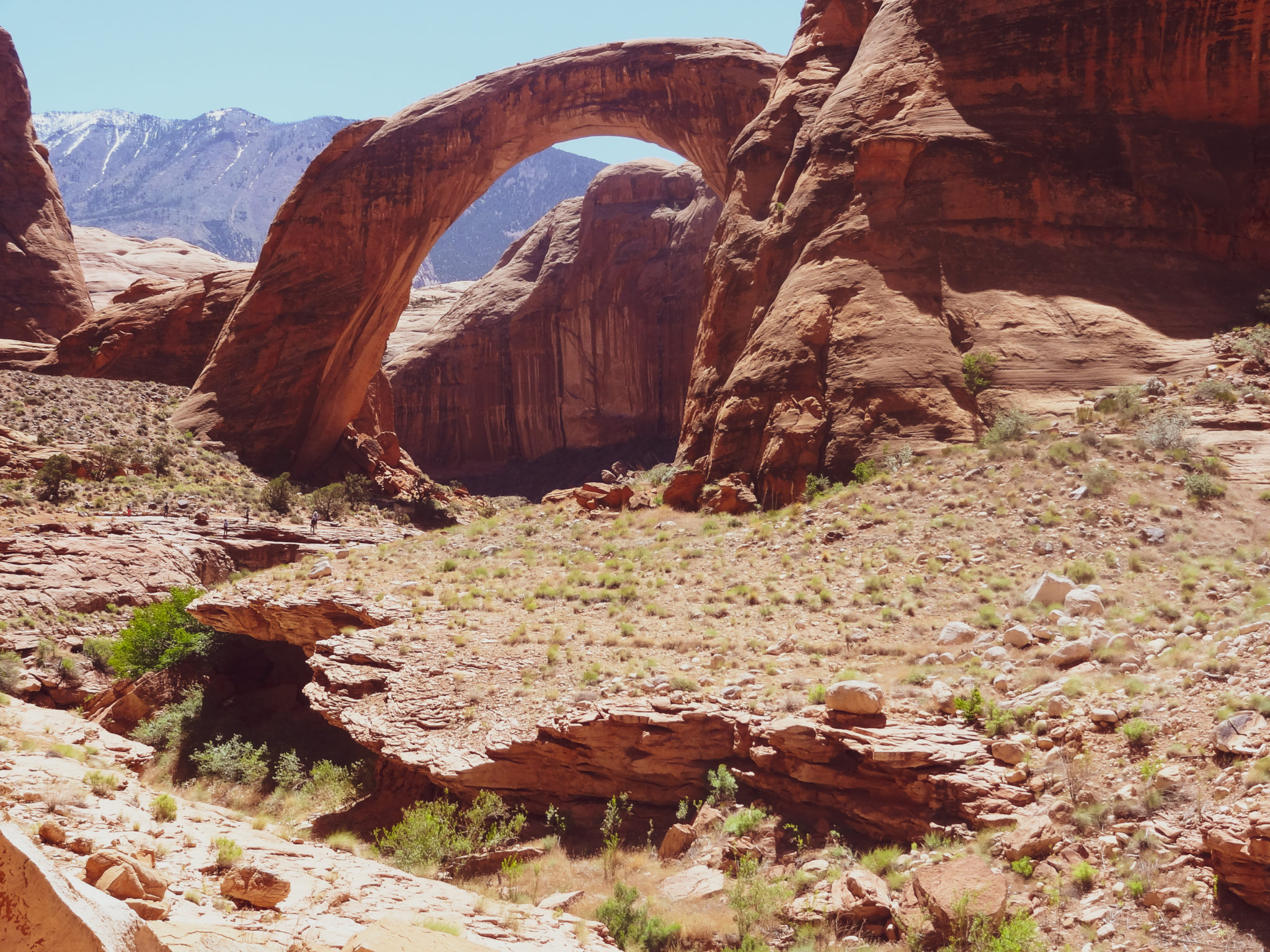


Other National Parks Near Las Vegas
There are other National Parks Near Las Vegas that we were not able to include in this road trip. These include Joshua Tree National Park in California and Grand Canyon Parashant National Monument which is rugged open country that we were told not to explore without an off road vehicle or an extra set of tires. Our next Las Vegas road trip will definitely also include a visit to Sequoia and Kings Canyon National Park.
Conclusion
We are proof that you can build a great 1 week road trip of National Parks near Las Vegas and build in a lot of quality experiences! Hopefully this information can help you to plan your own road trip out west! So… are you ready!?!?! We’re excited to share!
Interested in more? Join our email list to get our newsletter where we share updates and itineraries like this one.
A National Parks road trip from Las Vegas is well worth the time and effort to accomplish! It invites both peace and adventure and gives many memories and opportunities to learn.
I loved the route that we took, and would do it again in a heartbeat! The primary thing that I would do differently the next time is to spend more time in each place (and maybe wait until the snow cleared completely at Cedar Breaks 😉 – just sayin’).
Also, if you want more travel ideas, take a look at our destinations page where we organize trips by state.
>>Join our email list for our free newsletters.<<
We want to hear your stories! Have you embarked upon a similar journey? Any questions that we can help with while planning your own road trip from Las Vegas? Drop us a note in the comments below.
Happy Exploring!
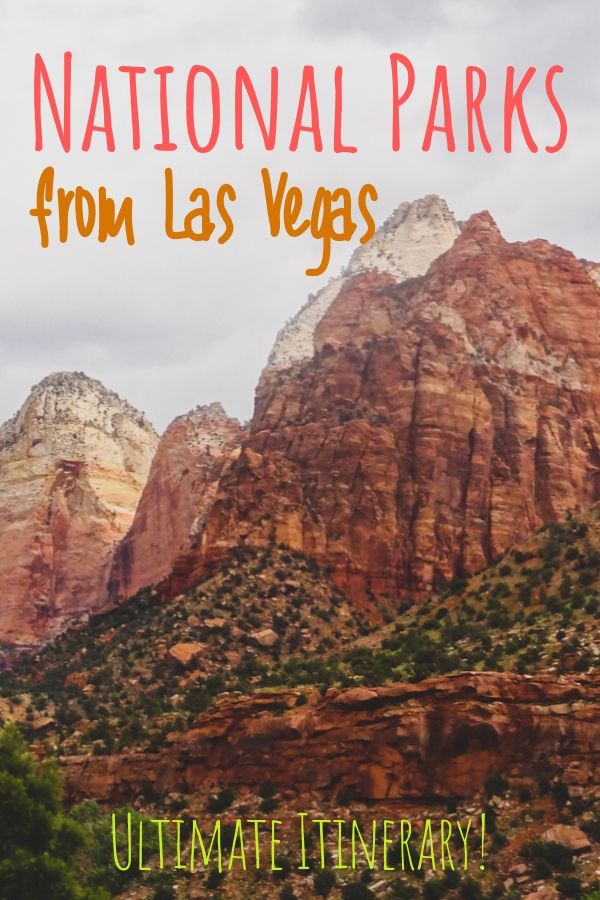


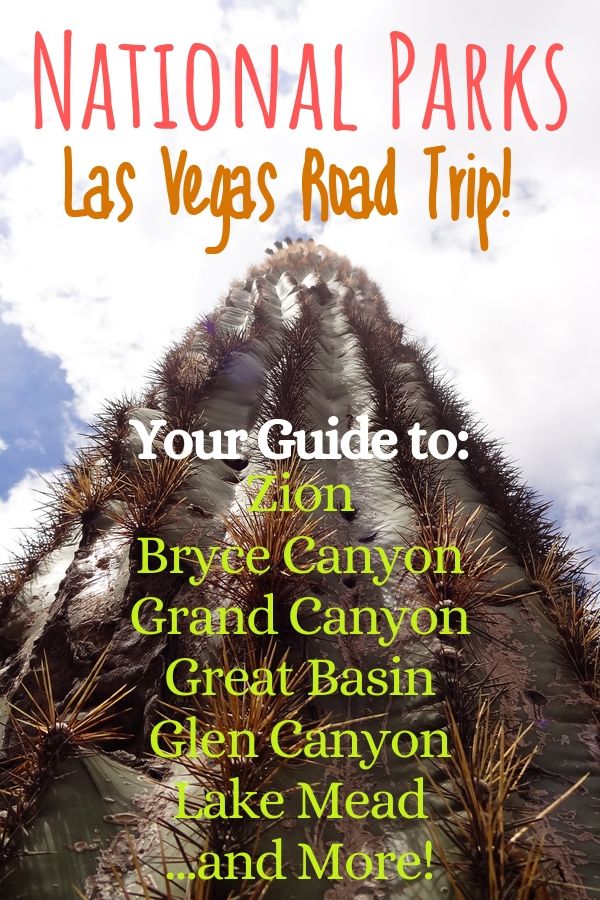


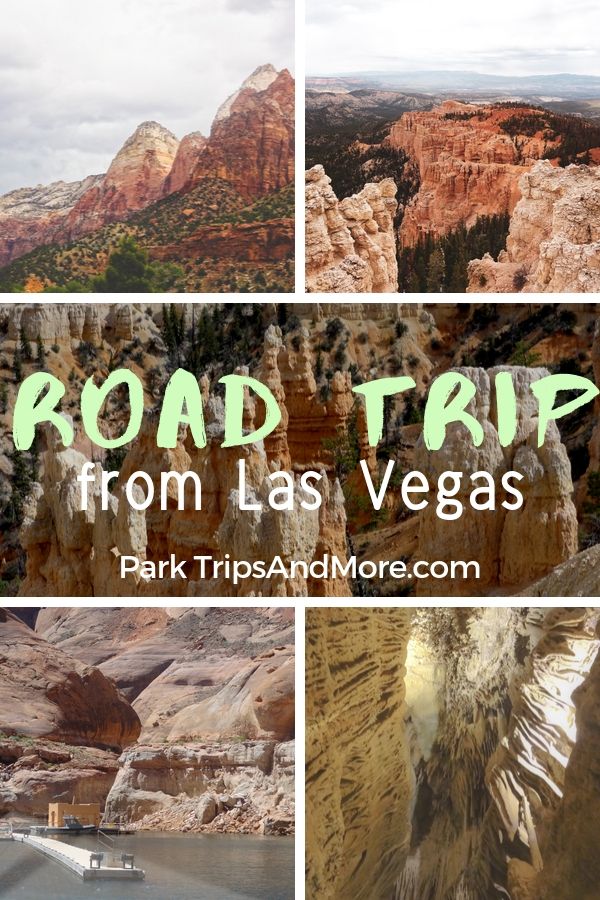


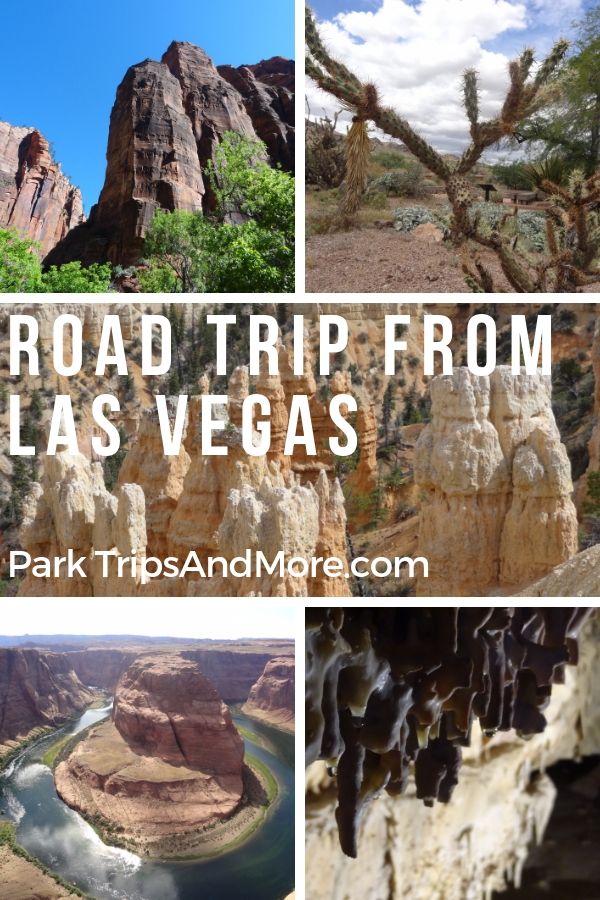




7 Comments
My family is planning to make a similar trip in just a few weeks. I’m wondering if you both are avid hikers that workout for this in advance and if I’m going to need to do some serious working out between now and then?? Because I don’t want my family to hike off and leave me. Signed a happy Walker but not much for climbing or dying.
Hi Heather – thank you for your question! While we both enjoy getting out and hiking, I would say that we are hiking novices. We tend to stick to easy to easy-moderate trails, and (for my benefit) limit the amount of hills and steep inclines that we attempt. That being said, all of the hikes mentioned in this post are on the easy to easy-moderate side of the spectrum.
I will say that the short jaunt up to see Zabriskie Point at Death Valley was pretty steep (even though it was paved). It’s close to the parking area, so if you start it and think it’s too much, you can always turn back around and skip it.
Also, the most difficult hike for me overall was the ~1 mile walk from the boat back to Rainbow Bridge. While it was pretty flat, it was hot and dry day which made it feel a lot longer than 1 mile. If you take your time, wear good shoes, and carry lots of water to stay hydrated, it’s very doable though for a person in reasonable condition. (As a side note, I’d seek out this experience one hundred times over – while this was the most difficult hike for me, it was so worth it to see this magnificent site!!!)
The hike to Horseshoe Bend was fine (mostly downhill after an initial uphill push). Walking back up the hill on the return trip was pretty strenuous in my opinion (and we were already tired from experiencing Rainbow Bridge earlier the same day). While it’s an absolutely magnificent view, I probably felt the most uncomfortable here. When we went, we saw folks taking crazy risks to get “Instagrammable photos” that made my stomach drop… I’d just caution any visitor to stay safe here and don’t take unnecessary risks. If I had to drop one single hike from our list, it would be this one.
As a benchmark, we have sedentary / desk jobs, but do try to take walks around our neighborhood pretty regularly (usually just a quick, 1 to 3 miles a few times a week). We’re both generally healthy, but not particularly fit.
Like I said, I’m a hiking novice, so the depth of my experience is limited. What’s worked for me though is to be reasonable about what I can do. It’s exciting for me to think about hiking Angel’s Landing at Zion, for example – especially when I see the gorgeous photos that others have taken… BUT… I know that’s an experience that I’d have to prepare for in advance. I tend to try to test the limits of my strength and endurance at home, and enjoy within my comfort zone when at the parks.
My motto is to “hike your own hike”, take your time and enjoy it. It’s ok to take breaks if you need. Be prepared, listen to your body (it’s ok to turn around / not complete a hike when you’re uncomfortable), wear good shoes, and stay hydrated – especially in the heat!
Enjoy your trip! I’d love to hear how it goes!
…one more thing… if you look at the National Park Service site for any particular park that you are planning to visit, you can typically look under “Plan Your Visit” and then “Things to do” and find information about the hiking in the park. They often will have difficulty scores, distances, and descriptions of all of the trails available to hike in the park. This might be a good guide as well (and one that we often consult when we prepare for our trips).
Best always!
Planning a family “Red Rocks and Cacti” road trip to national parks in Utah and Arizona for post-covid, came across your site –
I appreciate that you included some reflection on the Native peoples who still live in some of these locations, and how that may not be benefiting from trickle-down effects, etc. That is really something to be aware of.
That sounds amazing – enjoy your trip! We’d love to hear about it. Visiting the parks has definitely made us more aware of the history that surrounds our public lands – especially out west. I think that developing an appreciation will serve to enhance your experience for sure – you are in for a treat! Be safe!
What an experience! Awesome photos!
Thanks Mom! It was such a great trip… I cannot wait until we get to explore some more. We’re really working on sharing more photos from our trips. It’s funny because we have a bzillion of them 🙂 A picture is worth a thousand words, right?